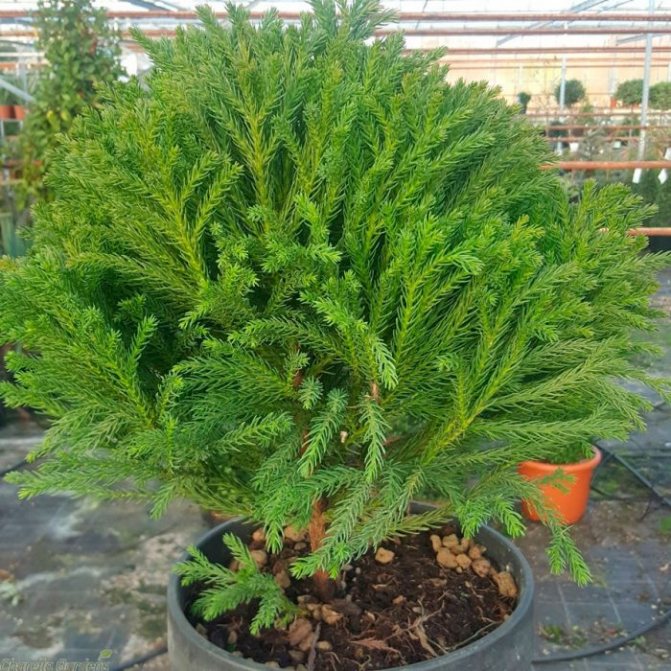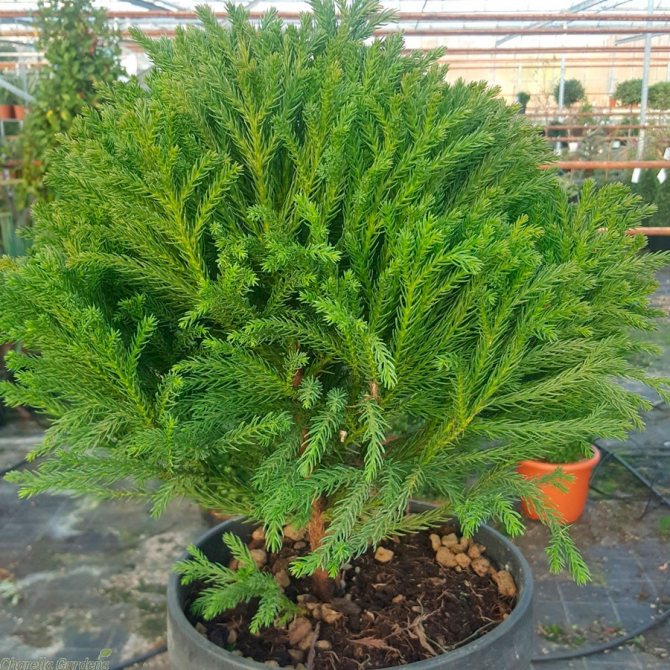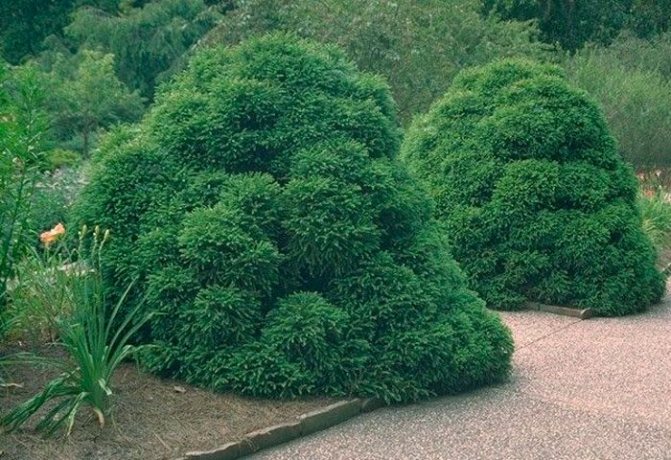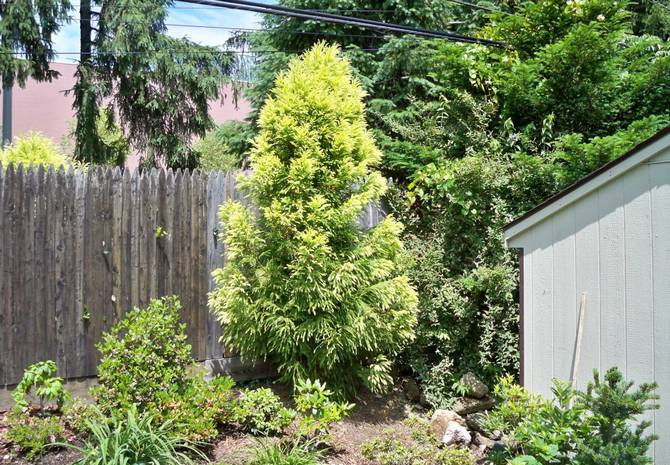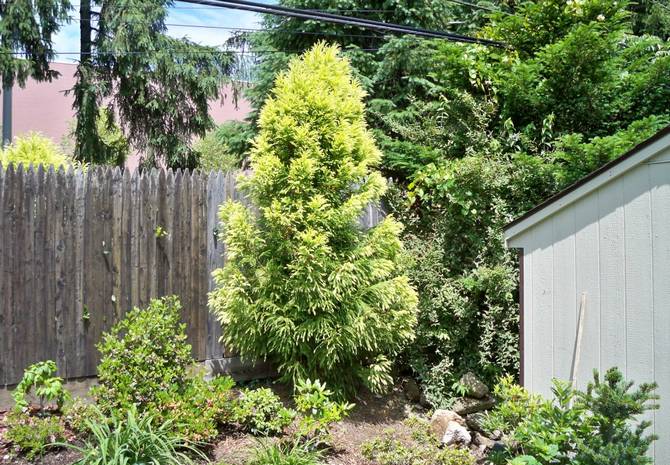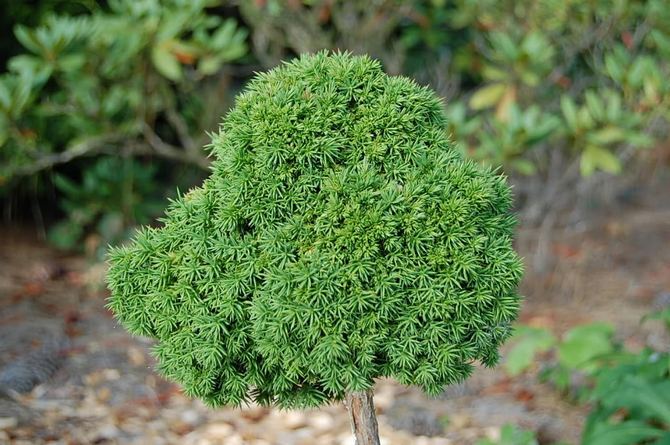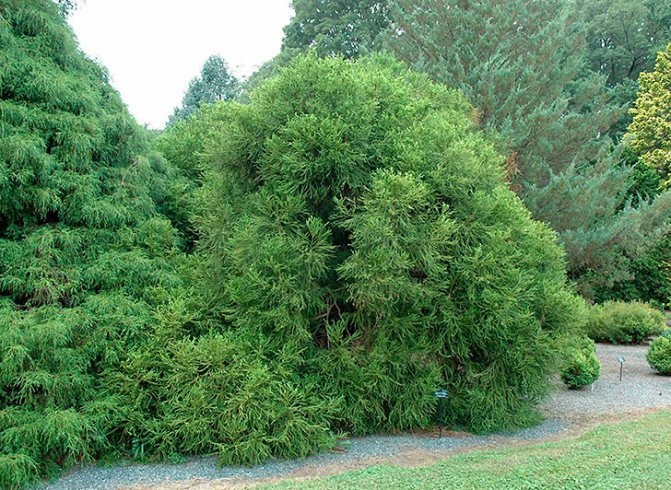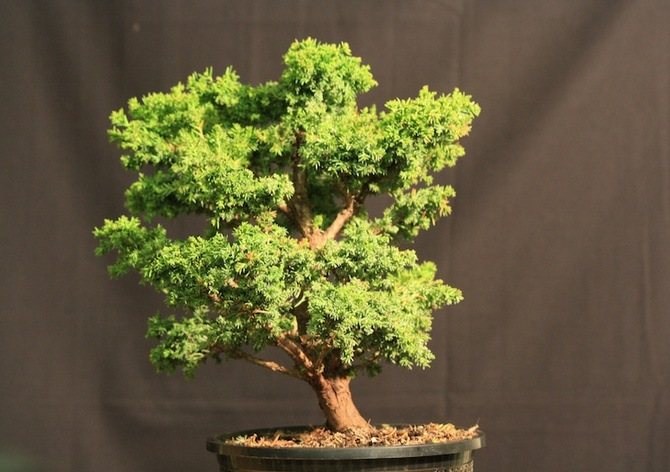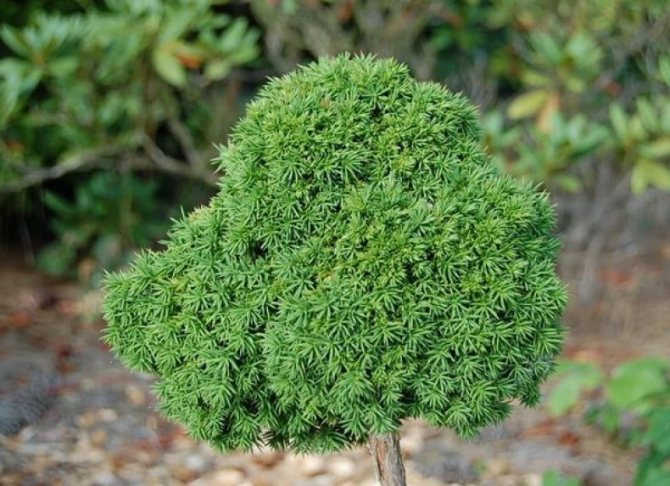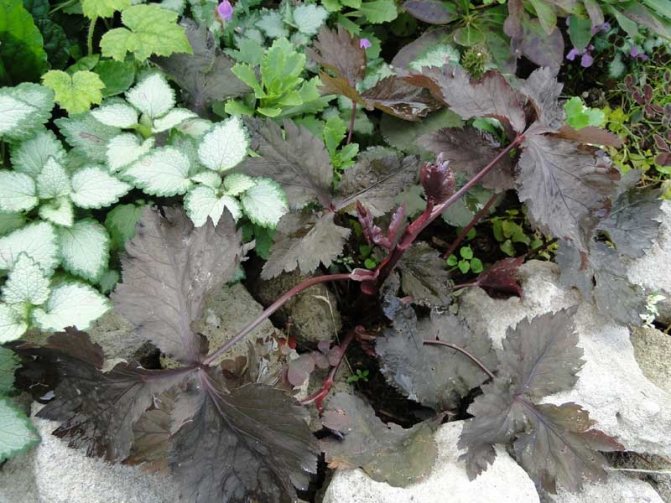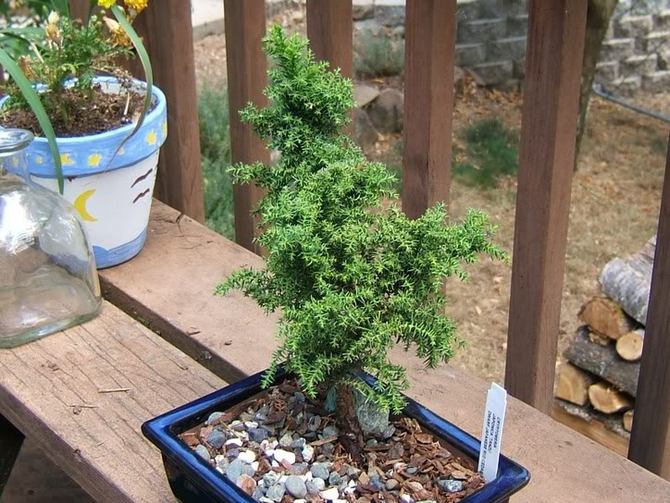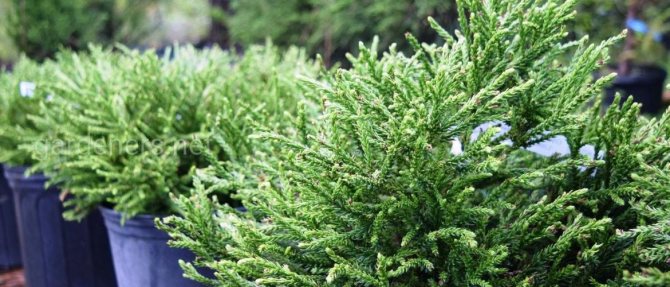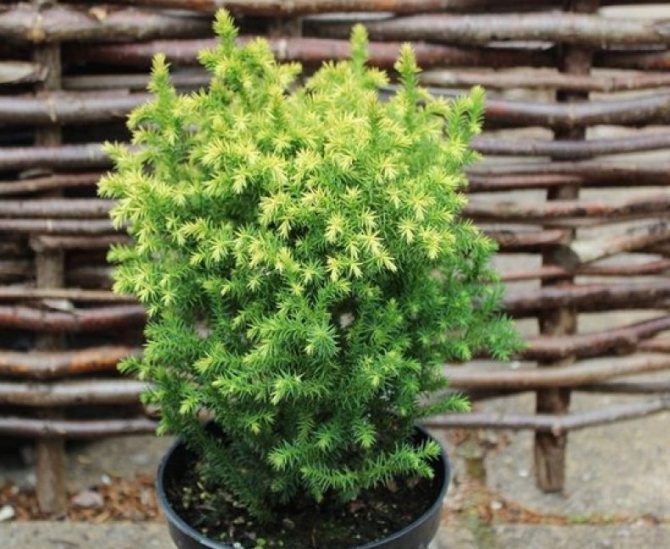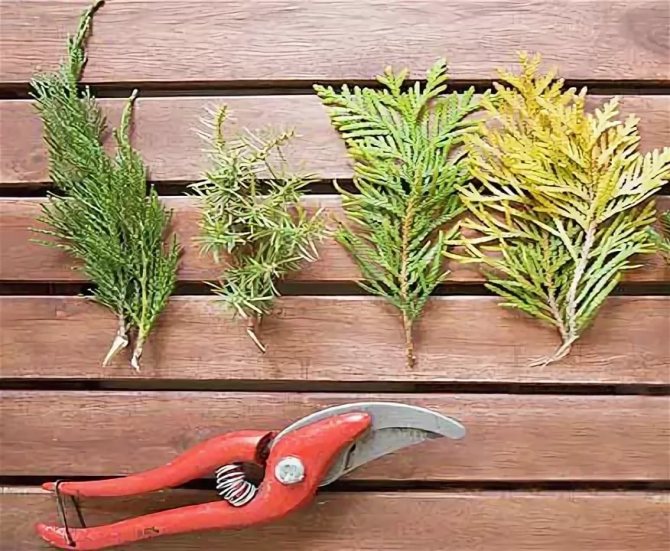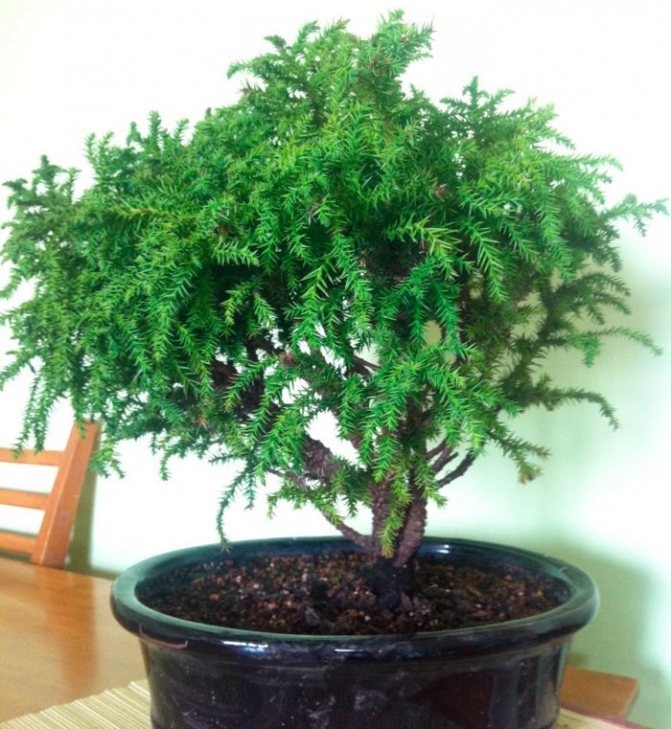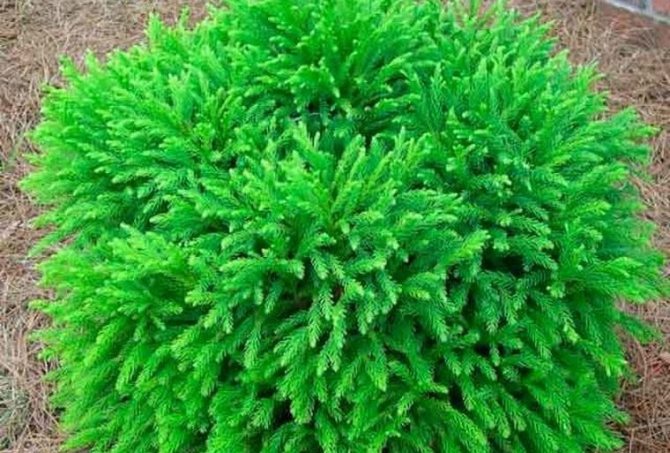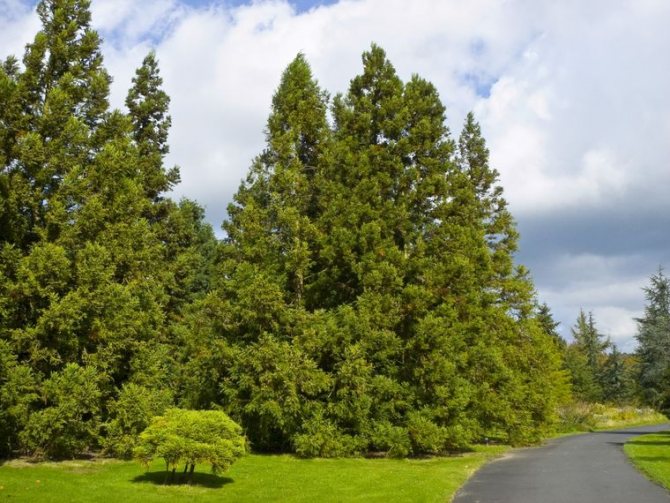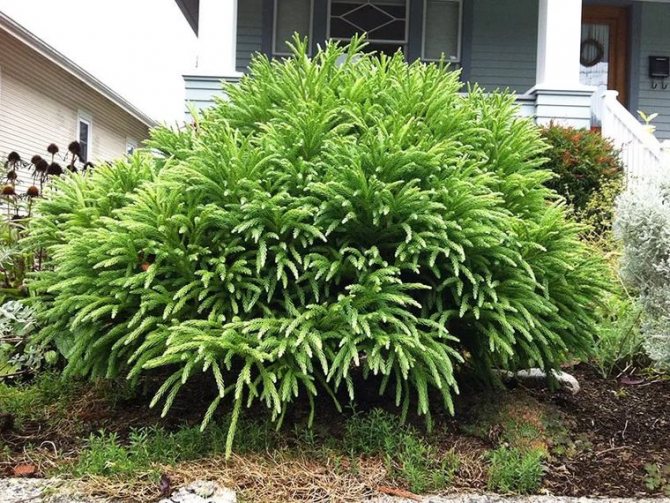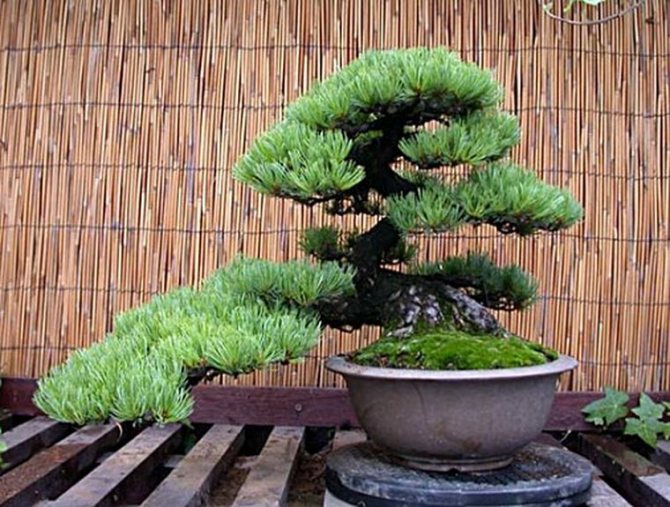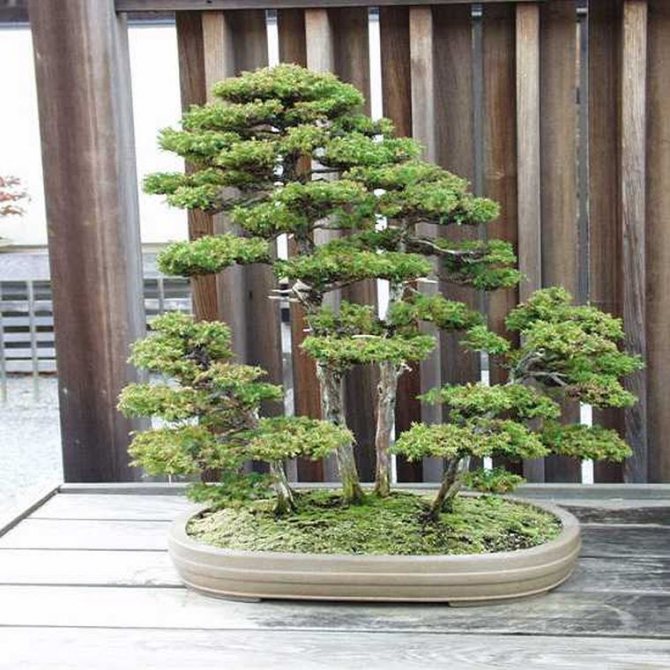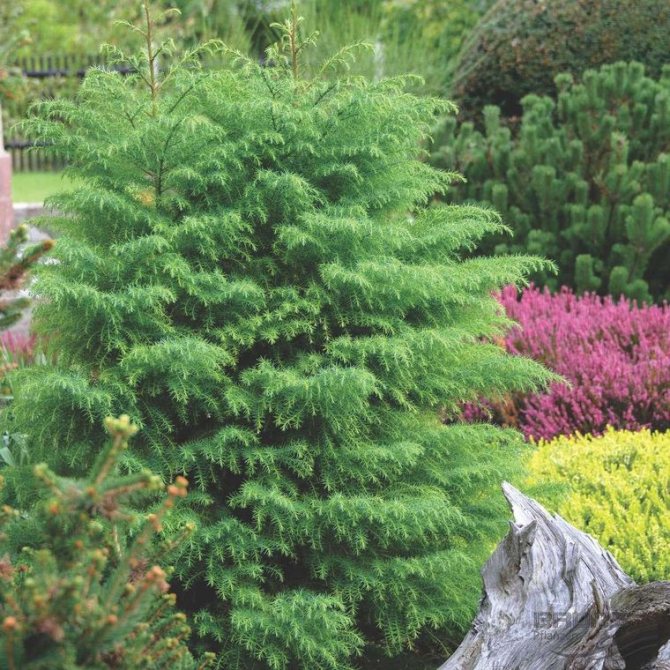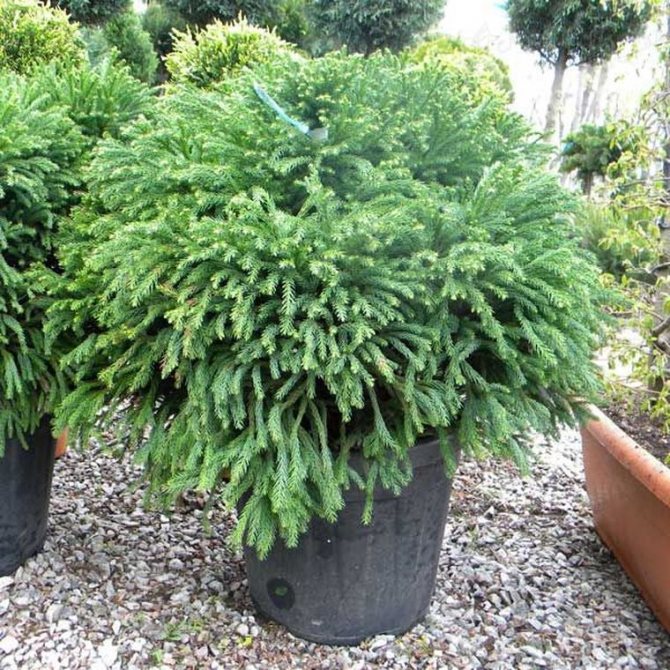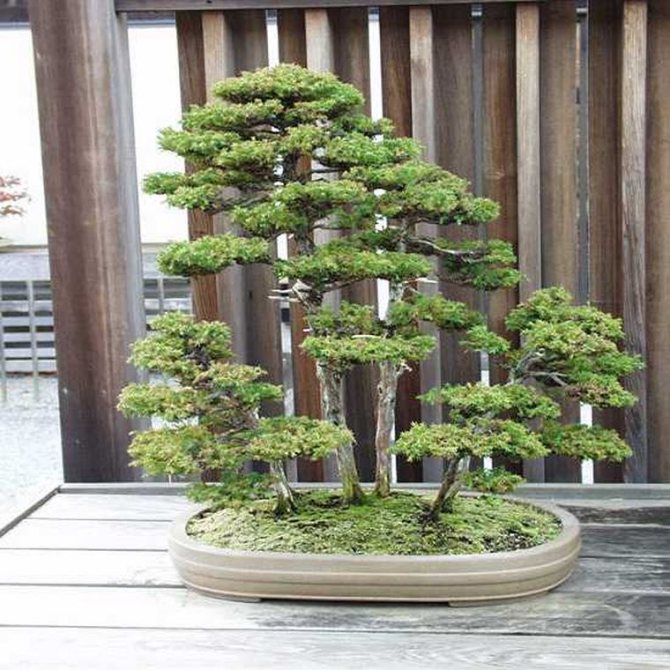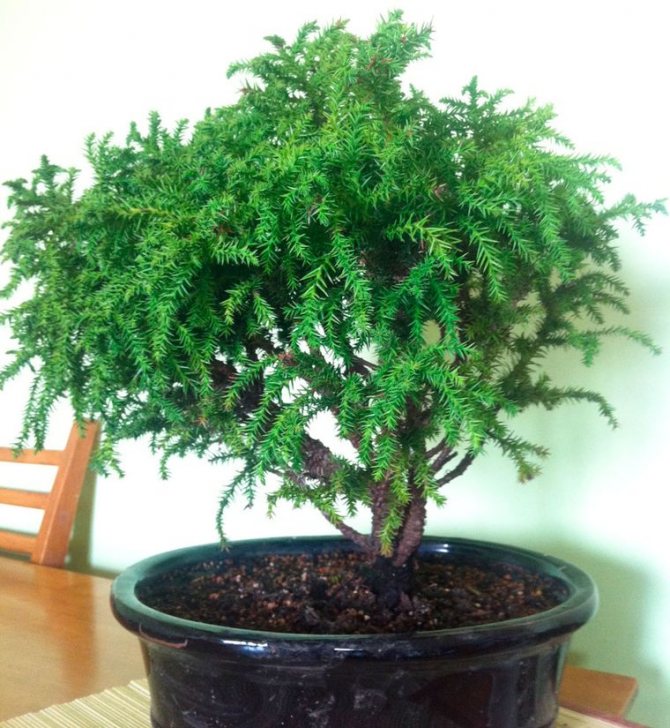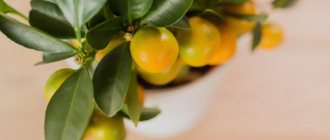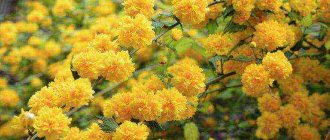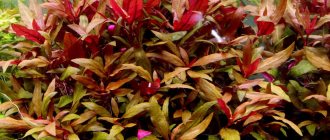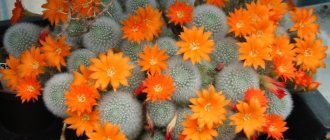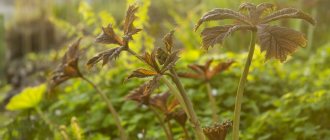The more you admire cryptomeria, the more you fall in love with it. This, so far, is a rather rare tree in decorative gardening. But if you remember that nature has no limit to perfection, then cryptomeria definitely proves this belief.
Japanese cryptomeria (Cryptomeria japonica) is an evergreen tree belonging to the amazing Cypress family (Cupressaceae) and sometimes called the mysterious Japanese name "sugi", charms the soul with a thick, but at the same time modelly slender crown, colorful brownish-red fibrous bark.
Under natural conditions, cryptomeria grow in Japan and China, reaching 40 m in height. Their crown is narrow-pyramidal, the trunk is straight, cylindrical. The needles are three-tetrahedral, light green, even rather emerald, located on the shoots gracefully in a spiral. It is slightly curved at the base, but this only emphasizes the naturalness and originality, adding even more expressiveness to the plant. Cones are solitary, spherical, up to 3 cm in diameter, ripen within a year and after a rash of seeds remain on the tree for a long time.
In Japan, cryptomeria is a valuable garden and park plant; many cultivars and varieties have been bred here. This coniferous plant is also popular in Germany, where about 20 different forms are also cultivated. Cryptomeria grow well on the Black Sea coast. The cold northern climate makes it difficult to grow Cryptomeria easily and without problems, but under certain conditions it can be used to decorate gardens.
Before deciding to plant this exotic, it is important to understand that successful wintering depends on the correct choice of the variety. The thermophilic cryptomeria grown from the brought cuttings most likely will not survive the winter. But many winter-hardy varieties bred in Germany can be successfully grown in the south of Russia, in Ukraine, Belarus, and in the Baltic countries.
For a harsh frosty climate, the dwarf form "Globosa nana" is suitable, which is grown in large ceramic pots, covering for the winter in a greenhouse or a warmed loggia. This cryptomeria in parks reaches a maximum of 2-2.5 meters. Shoots are very dense and uniform, slightly raised. The twigs are curved. The needles are short, dense, of unequal length, light green. It tolerates up to -12 degrees of frost.
The "Vilmoriniana" variety is popular. For a year, it gives an increase of only 3-4 cm, so it is often grown as a houseplant in a cool winter. In winter, its needles acquire a reddish-green color and serve as a wonderful decoration for the garden.
What is cryptomeria
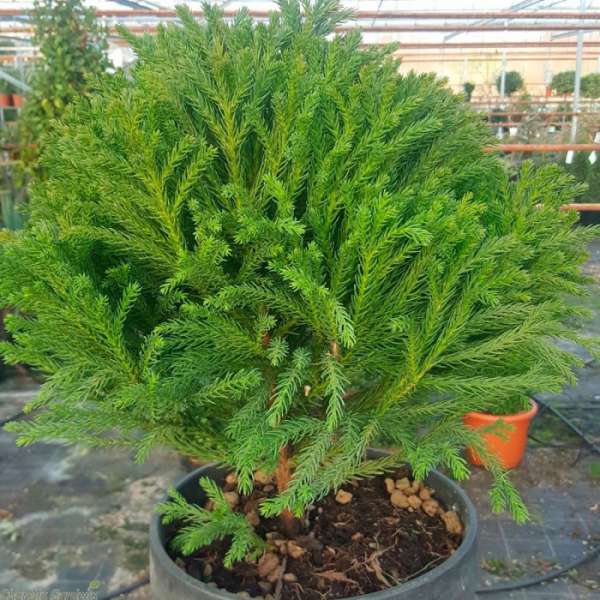
The homeland of this ephedra is China, and this plant belongs to the cypress family. In Japan, cryptomeria is revered and considered by many to be a national symbol. In the wild, there are plants that are many hundreds of years old and their trunk has not only an incredible thickness, reaching in some cases 2 meters, but also a height of 60 meters.
This evergreen tree has a lot of external similarities with the araucaria. His crown is pyramidal, and dark green needles with a bluish tint are 3 and 4-sided. In Europe, they learned about this plant only in 1842.Since that time, cryptomeria is considered a valuable plant for landscape design.
Description of the plant
In the wild, cryptomeria is a huge tree: its trunk can reach two meters in diameter, but in height it stretches up to sixty meters. Of course, it reaches this size only at the age of several hundred years, and not every specimen will live up to such a respectable period.
Cryptomeria looks impressive and charming at the same time. It is an evergreen plant with a pyramidal crown and a straight cylindrical trunk.
Its branches are dotted with needles of a light green shade, covering the shoots in a spiral. He also has cones - single and round, up to three centimeters in diameter.
This tree belongs to the cypress family and is the only species in the genus Cryptomeria. He also has a popular name - Japanese cedar. And although it has no connection with cedars, this name is so entrenched in cryptomeria that it is often used to this day.
Its homeland is China and Japan, so it feels great in the humid subtropical climate of the East. There it grows in forests or alleys, growing to enormous height and width. Of course, when gardeners and botanists were interested in cryptomeria, most of them understood that such a giant simply would not fit on a garden plot. Therefore, various forms of the tree were bred: both variations for the garden, reaching several meters in height, and small, dwarf ones for bonsai.
Garden forms


There are more than a couple of hundred species of this conifer. An incredibly beautiful monoecious plant, the pyramidal crown of which has a shape reminiscent of a pin, which looks very impressive and elegant. All species of this coniferous tree love moist acidic earth and plenty of sunshine. Taking care of them is easy enough.
Main varieties
For cultivation in the garden, the following forms of cryptomeria have been bred:
- The plant is distinguished by its short stature, long shoots with thick spirally twisted needles. This is the main feature of this species.
- The evergreen tree has a straight trunk and grows up to 2 m. Sprawling branches with a large number of branches form a beautiful crown, which only increases its decorative effect.
- The ephedra is compact in size; rosettes of needles are formed on its numerous branches. It is noteworthy that their color changes depending on the season: in the spring-summer time - green with a bluish tint, and closer to winter - red-brown.
- The plant is distinguished by the presence of two trunks and a large number of long, chaotic branches. They are covered with short dark green needles.
- Elegance height reaches 10 m. On dense branches there are soft long blue-green needles. By autumn, their color changes to purple or brown. Small cones can only form on young plants. The advantage of this form is a high degree of resistance to adverse environmental factors.
Among indoor types of cryptomeria, the following are very popular:
- Banday-sugi
... This stunted plant is distinguished by the ability to form many spreading shoots. They are covered with thick and tough needles of green-blue color. - Vilmorin Gold.
The Japanese cryptomeria Vilmorin Gold has an annual growth of 3 cm, which is very convenient for home cultivation. The needles change from dark green to red-brown in winter. Withstands subzero temperatures normally. - Dwarf ephedra
surprises with its white needles, which is very unusual and decorative. As they grow older, this color changes to light green. - Globosa nana.
This type of Japanese cryptomeria has established itself as a frost-resistant culture, it can be very often seen in parks. The plant is not afraid to drop the temperature to -12 degrees. When grown in open areas, its height does not exceed 2.5 m, excellent for indoor conditions. On the shoots, various caliber needles of a light green color are formed.
# gallery-2 {margin: auto; } # gallery-2 .gallery-item {float: left; margin-top: 10px; text-align: center; width: 33%; } # gallery-2 img {border: 2px solid #cfcfcf; } # gallery-2 .gallery-caption {margin-left: 0; } / * see gallery_shortcode () in wp-includes / media.php * /
Several common types
- "Golden" - this species stands out from the rest in that its young shoots have a very unusual yellow-golden color.
- Vandai-sugi - such a conifer is very popular among European gardeners and belongs to the dwarf form. The tree grows not very tall and has fluffy spreading branches, which are decorated with green needles, which have a beautiful bluish tint.
- Elegans (slow growing) - this tree has feathery needles of a very unusual shade. In summer, it is colored green-brown, but as winter approaches, it changes to violet-green and red-bronze. This variety just feels great in mid-latitudes. It has properties such as smoke, frost, dust and drought resistance. Also, this plant can be grown in partial shade, without fear that this will somehow negatively affect the color of the needles or the growth and development of the tree itself.
- Vilmoriniana - this dwarf tree has gained popularity among gardeners precisely for its short stature. For 12 months, this beauty with lilac-red needles grows only 3-4 centimeters. In the garden in the winter snowy months, it looks especially impressive.
Types of cryptomeria


"Cristata".
The form has narrow, straight outlines, height parameters do not exceed 6–8 m. It has raised short branches. The contours of the short and rigid branches are bent, often they have wide ridge-like "bandages", which after a while acquire a brown color and die off. In the period 1900, such a plant was exported from Japan to Germany by Unger.
Elegans compacta
has dwarf outlines, can reach a height of 2 m. The type of plant is flat-round, rather squat, lateral shoots differ in various lengths, can sometimes die off. The length of the needle-leaves is measured 20 mm, they are located at a distance from each other, their surface is soft, in the summer, the color is bluish-green, which acquires a purple tint in winter.
- Globosa.
This form has smaller parameters in height than in width, its crown is round to flat-round. The plant does not exceed one and a half meters in height. The branches have elongated contours, the ends are bent down. The length of the thin needles is 1–1.5 cm. Their color is bluish-green, becoming rusty-red in winter. The form is winter-hardy, but less decorative than the winter "Globosa nana". In 1942 it was already on sale in Holland.
For more on Cryptomeria care, see below:
The use of cryptomeria in landscape design


Certain varieties of this evergreen tree are used in Japan to make bonsai. Also, cryptomeria is especially appreciated in park and garden construction.
The work of breeders has resulted in varieties that can be used in the arrangement of recreation areas.
Garden ornamental varieties are very often planted in parks, and are also used to create forest shelter belts. And the alleys with staggered cryptomeria look very impressive, thanks to which a feeling of dense solidity is created.
Due to the fact that practically the species of this evergreen ephedra are quite thermophilic, they are not planted in regions where severe frosts are observed in winter. Such trees feel very good on the territory of the Black Sea coast and in the Caucasus.
Some growers who are madly in love with cryptomeria grow it at home. This very beautiful tree with a neat crown feels great in indoor conditions. On average, it can grow up to 2 meters in height.
In the winter garden, hall, as well as on balconies or terraces, this plant also feels quite well. For planting, dwarf varieties are chosen, and trees are planted, as a rule, in voluminous tubs. To contain the growth of cryptomeria, it is extremely rarely transplanted, and also infrequently fed. This plant helps to significantly improve the indoor microclimate.It releases essential oils into the air, which have bactericidal and antiviral properties, as well as negative oxygen ions.
Regions of Cryptomeria Cultivation
Cryptomeria of the fireweed family attracts attention with its natural beauty. In the middle of the 19th century, it began to be cultivated in Europe.
Today, Japanese cryptomeria has given birth to many varieties. There are crops for greenhouses, various indoor spaces, including for growing in a room.
Japanese cryptomeria bred by breeders is also used to decorate the house.
The garden forms of the evergreen beauty are especially common in areas with a mild subtropical climate. In Russia, the plant is popular in the Crimea and the Caucasus. Fluffy trees of a beautiful pyramidal shape adorn parks, gardens, greenhouses in these regions.
German gardeners have grown over 20 varieties of this unique plant. Winter-hardy varieties stand out among them. However, a temperature of 10-12 degrees below 0 for these forms of evergreen cryptomeria is a rather difficult test.
Dwarf plant varieties do not exceed two meters in height, there are domestic species with a height of no more than 1.5 m. Such crops are grown mainly as tubs.
How to care for room cryptomeria
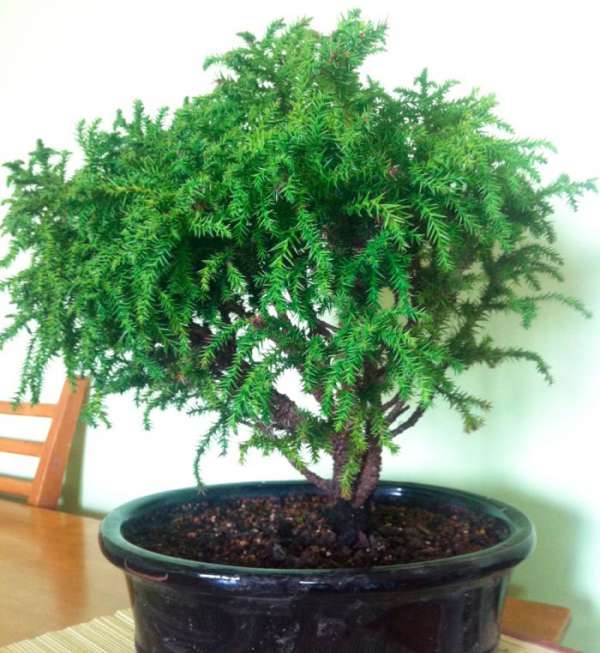

Location features and illumination
As mentioned above, this plant is quite photophilous, but it should be noted that when grown at home, it must be protected from direct sunlight. This evergreen conifer can be grown and placed in partial shade. But it's still better if it receives enough light. In the event that the plant is not very large, then the pot with it can be installed in the walls between 2 windows.
Temperature regime
In the summertime, the tree is best taken outside. But if this is not possible, then at room temperature it will feel quite acceptable. It is worth considering that the room in which cryptomeria is located must be ventilated very often, since it reacts extremely negatively to stagnant air. Regular ventilation should be carried out both in summer and winter.
In winter, it is necessary to ensure that the room where this conifer is located is not higher than 12 degrees, since the high temperature is contraindicated for it at this time.
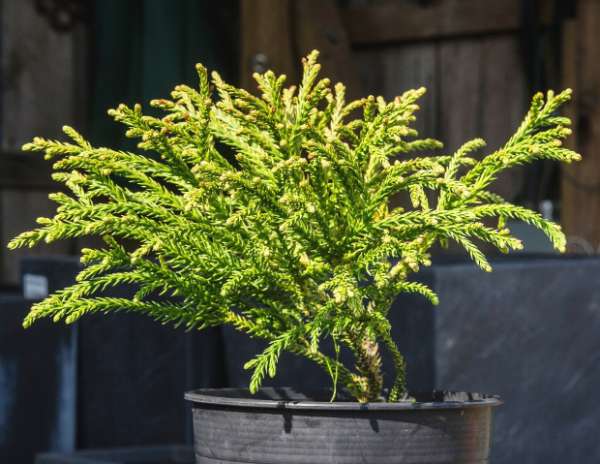

How to properly water and feed
Watering should not be too frequent. In general, you should stick to the middle ground. So, the earthen lump should in no case dry out. But you should also not allow stagnation of water in the soil. Otherwise, rotting of the root system may begin, and as a result, cryptomeria will die. In this regard, during transplantation or planting of this plant, it is imperative to take care of drainage.
This tree needs frequent spraying. It must be carried out at least twice a day, and preferably more times. If this is neglected, then the needles will begin to turn yellow and fall off. Watering and moistening the plant is necessary with plain water, but it must be warm (20-25 degrees).
Cryptomeria should be fed only a couple of times a year and in the summer months. For this, mineral fertilizers are used, diluting ½ part of the recommended dosage in water.
Transplant features
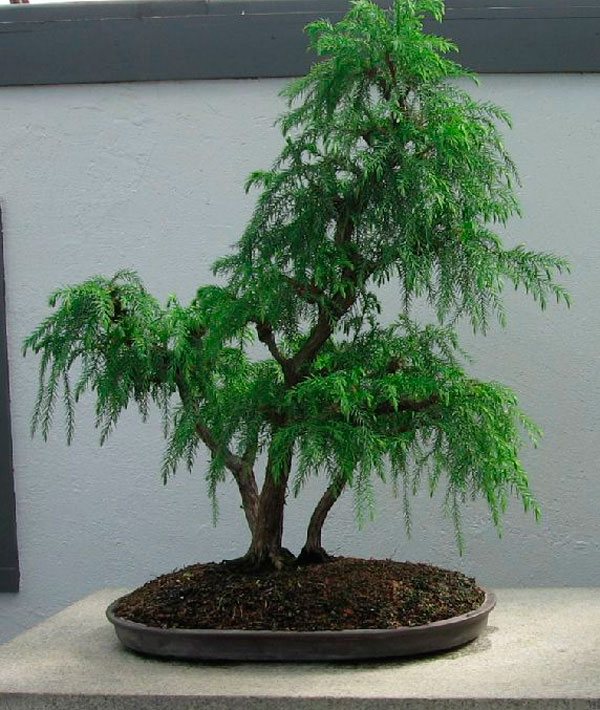

In the first few years of life, this ephedra is transplanted annually. However, it should be borne in mind that this should not be done without special need. Transplant this plant with extreme caution. The thing is that if this procedure is carried out regularly and you take a pot even a little larger than the previous one, then because of this, a very intensive growth of cryptomeria can begin. The same result can be achieved with rare transplants, in the event that the pot is much larger than the previous one.As a result, instead of a beautiful and neat dwarf ephedra, you will grow a huge tree.
Of course, the tree grows, and sooner or later the moment comes when a transplant is simply necessary for it. It is important to take into account that this procedure must be carried out very carefully, and it would even be better to limit it to transshipment. This ephedra has a very sensitive root system and it is better not to disturb it unnecessarily. In springtime, in adult cryptomeria, only a change in the upper layer of the earth is made.
Reproduction of cryptomeria
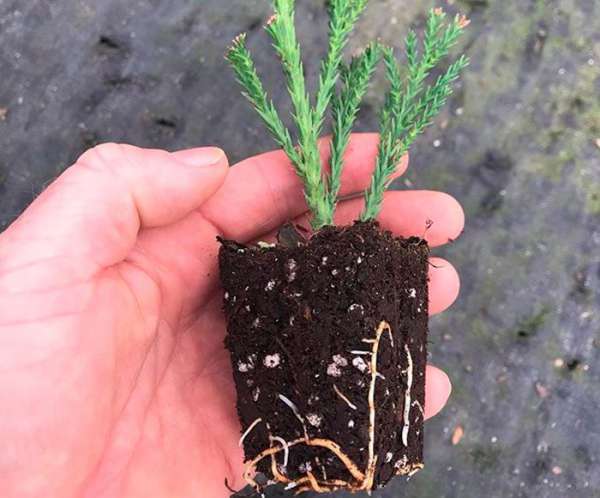

You can grow this tree, if desired, from a cuttings or seeds. The second method is quite complicated and is suitable only for experienced florists, as well as breeders. It is best to use the first method for reproduction. To do this, you will need to cut off a non-lignified stalk and put it in a glass of water. It can be pretreated with a preparation that stimulates root growth. After the roots appear, the cutting should be planted in a prepared pot with soil (leafy earth + sand + turf soil taken in a ratio of 1: 1: 1). If everything is done correctly, then soon the young cryptomeria will take root and begin to grow.
Many gardeners dream of getting a beautiful plant that will be easy to care for and can grow at home. Especially pleasing to the eye evergreen trees,
but most of them are very difficult to grow at home.
One such attractive and evergreen tree is cryptomeria. In this article, we will consider what cryptomeria is and what kind of care is needed at home.
Bonsai varieties
Besides garden trees, there are other forms of cryptomeria that make up bonsai. As a rule, these are the varieties that grow most slowly, due to which they can remain low for a long time. The most popular ones are:
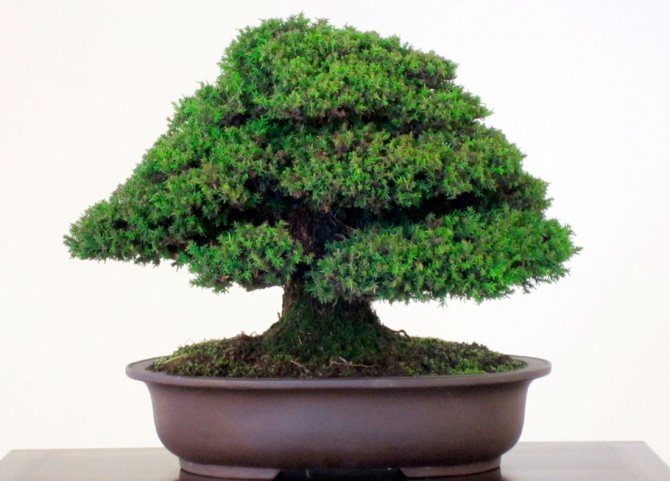

Banday-sugi is a bush with many spreading shoots overgrown with thick, tough blue-green needles.- Vilmoriniana is one of the best varieties to grow as a bonsai: it grows only 3 centimeters per year. In winter, its needles change color to red-brown. The tree tolerates cool winters well.
- Nanaalbospica is a bonsai with amazing white needles. With age, however, they change color to a pale green.
- Globosa nana is the most hardy variety, often grown in parks. Able to withstand temperatures as low as -12 degrees. In open conditions it grows to a maximum of two and a half meters, but it can also be grown as a bonsai in pots. She has short needles of different lengths of a light green shade.
There are many other varieties, the variety of which allows anyone to purchase the right bonsai or tree for the garden.
Cryptomeria: description and types of coniferous plants
To begin with, consider the conditions under which cryptomeria grows and its main characteristics. This plant belongs to evergreen trees of the cypress family.
Cryptomeria is also known as Japanese cedar.
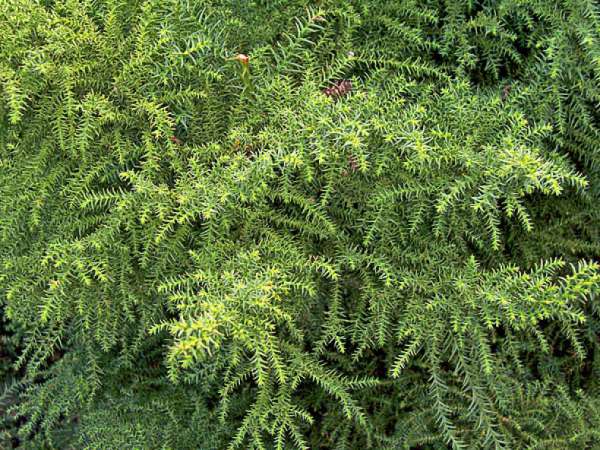

This variety includes "Cryptoméria japónica" (Japanese cryptomeria). The crown of this decorative variety is quite thick, and the color varies from light green to dark green.


Japanese cedar is very popular in landscape gardening.
Dwarf varieties are often used when planning the landscape design of recreation areas, in park landscaping. Thanks to selection, there are dwarf forms that grow beautifully on terraces, in conservatories or on balconies. At home, cryptomeria reaches a height of approximately 2 meters. The cryptomeria of such dwarf species and varieties as “Elegans”, “Vandai-sugi”, “Araucarioides”, “Dacrydioides”, “Compressa”, “Globosa”, “Vilmoriniana”, “Еlegans compacta” is popular among gardeners.
Variety "Vilmoriniana" characterized by reddish-purple needles. This type of cryptomeria grows 3-4 centimeters per year, which is very convenient at home.
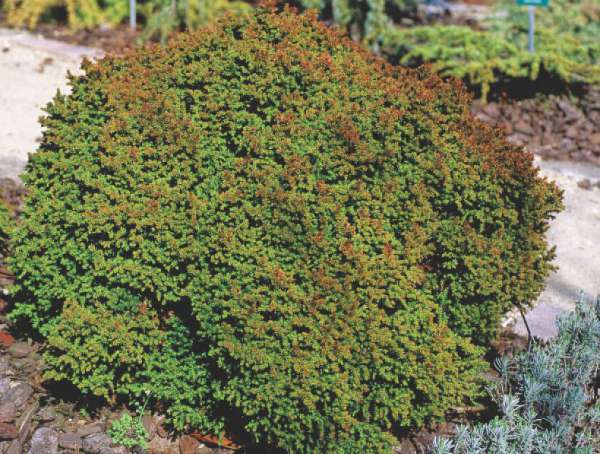

Variety "Wandai-sugi" has a bluish green needles color. Spreading branches. This variety is very popular in Europe.
Description
The type of cryptomeria (Cryptomeria japonica) is one of a kind, and it belongs to the Cypress family (formerly Taxodiaceae, but now both families are united under the same name).
This plant is very ancient and impressive in size: by the age of 150 it can reach a height of 60 m with a trunk girth of 2 m. Its crown is dense, from dark to light green in color.
In some cultivated forms, the needles can be yellowish or reddish in winter. On flexible shoots - short styloid needles, with small, almost spherical, cones about 2 cm in diameter. Cones are brownish, solitary, ripening occurs in the first year.
Looking at these forest giants, it's hard to believe that they can be grown at home like houseplants. But at present, many different garden forms have been bred, among which there are dwarf ones.
Due to the fact that Japanese cryptomeria is easily propagated by cuttings, seeds and grafts, and also gives abundant growth, it has become quite popular in regions with a mild climate, such as the Caucasus and Crimea.
Here are some dwarf forms (no more than 2 m, and some up to 1.5 m):
Araucarioides Вandai-sugi Сompressa (round) Dacrydioides Еlegans compacta Globosa (round) Vilmoriniana
Where to locate cryptomeria
Thanks to the selection of cryptomeria, its cultivation at home has become available. Trees of these varieties have a compact formed crown, which looks elegant on balconies, in the hallway or on the terrace.
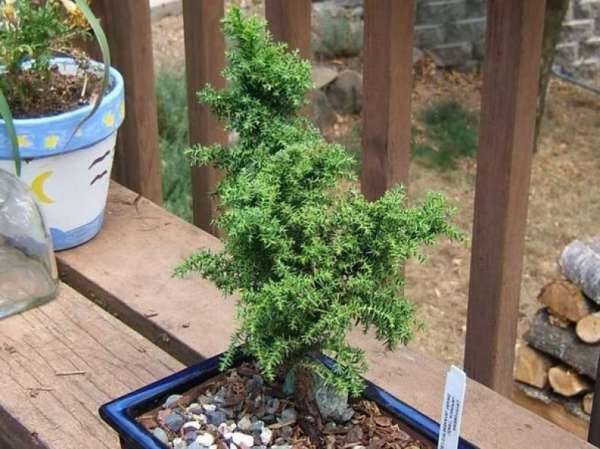

Choosing a place in the room: lighting
The main criterion for choosing a place in a room for a Japanese cedar is lighting. Cryptomeria - very light-loving plant,
however, it must be protected from direct sunlight. That is, the light should be bright and diffused. In summer, the plant will be comfortable outdoors in a small shade. A small, shaded patio, as an option for a place to grow cryptomeria, would be most appropriate.
Temperature and humidity for growing
Cryptomeria is not a thermophilic ornamental plant.


In summer, the best place for a tree is on the street.
If this is not possible, then the Japanese cedar will feel quite comfortable on a balcony with open windows or on an open terrace, even if the temperature reaches 20-25 ° C. In this case, the main condition is fresh air, since this ornamental plant does not tolerate stagnant air. Regular ventilation is needed for this tree in both summer and winter.
How to prepare the ground for planting cryptomeria at home
For planting Japanese cedar at home, a versatile mixture for common indoor plants is well suited. To such a soil, you can add soil for rhododendrons. Also, for planting Japanese cedar, you can prepare a mixture of leaf and / or sod land, sand and peat yourself.
Cryptomeria: How To Grow Japanese Cedar Indoors
Cryptomeria, or as it is also called Japanese Cryptomeria (Cryptomeria japonica), is an evergreen tree-like plant that goes into the Cypress family (Cupressaceae). There is only one variety in the genus and is popularly called the Japanese cedar. In Japan, this representative of the handicap is considered the national tree.
In China, this plant is called Shan, and in Japanese lands, Sugi, these two terms have almost everywhere replaced the old aforementioned name, since cryptomeria itself has nothing to do with the genus Cedrus and its name is considered erroneous.
During flowering, female and male flowers are formed. In females, the shape is rounded, the arrangement is single, such buds crown the ends of young shoots.Male ones are also formed singly, on young branches, while bundles are collected from them. They are covered with covering scales, which start from the bottom and go to the middle, growing together with the seed scales.
The contours of the seed cones are almost spherical, they can reach 2 cm in diameter, their color is brownish, they are located singly, ripening in the first year, and can remain on the branches even after the seeds are scattered. They have scales, the number of which varies in the range of 20-30 units, their shape is wedge-shaped, they are woody, they have three cotyledons (sometimes x-11).
Read also: How to plant and grow a cylindrical imperial
Shan is used for landscape gardening. Despite the rather impressive type of cryptomeria, dwarf forms have already been bred, which are successfully grown in indoor conditions. This plant has been in cultivation since 1842.
Cryptomeria landing technology
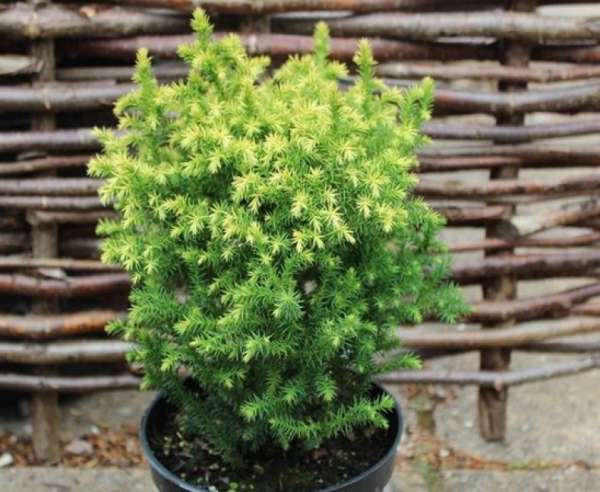

Let's look at the naturalization of cryptomeria, that is, how to plant it correctly. The technology is quite simple. The roots of Japanese cedar are very sensitive and the tree itself loves moisture and requires abundant watering. But at the same time, stagnant water leads to root rot. Therefore, good drainage should be placed on the bottom of the pot - expanded clay, pebbles or broken bricks. After planting, the tree needs watering.
In the early days, it is imperative to spray the plant several times a day. Cryptomeria quickly takes root and, with proper care, grows quickly.
Growing in the garden
To grow this tree in your garden, you need to pay a lot of attention to external conditions. You should carefully choose a suitable place with good soil and ideal light levels.
This tree feels best in warm places, protected from harsh drafts. Although it is photophilous, direct sunlight can harm it, so it can calmly grow in the shade of other trees.
The most comfortable temperature for her is up to 25 degrees in summer and up to 12 degrees in winter. In the cold winter, it will not survive, so many gardeners grow it in pots, which are transferred indoors during the cold weather.
The best soil for cryptomeria will be sour and moist soil. Areas with a high content of limestone or close occurrence of groundwater are contraindicated for it. In addition, the soil must be well-drained so that water does not stagnate. Otherwise, the plant may rot.
Only a few varieties of this plant are able to survive all year round in the conditions of central Russia. Therefore, it can be planted in open ground only on the Black Sea coast, in the Crimea and the Caucasus. It is ideally adapted to the climate of these places - you just need to choose a suitable area with the right soil, and it will grow successfully.
If the gardener is not so lucky with a warm place of residence, then cryptomeria should be planted in a pot.
Plants must be carefully monitored, maintaining conditions suitable for their life. It is important to water them on time, especially in spring and summer, from March to August. In winter, less intensive watering is needed, but the ground should always be slightly damp. You should pay attention to the appearance of cryptomeria: if its needles turn yellow, this indicates a lack of moisture in the soil.
How to grow indoor lemon at home
In addition to regular watering, you need to constantly spray the crown of the tree. It is advisable to do this at least twice a day. Sprinkling can be arranged in the summer.
You need to feed it every spring; for this, mineral or organic fertilizers are suitable. If cryptomeria does not grow well, you should repeat the feeding again in the fall. Newly planted young trees require special conditions. You cannot feed for two months after planting, and then you need to carry out this procedure twice every spring.
Features of caring for cryptomeria at home
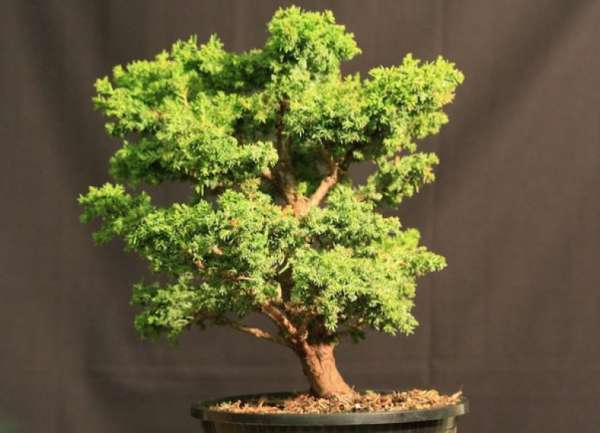

Caring for cryptomeria at home is quite simple and does not require high costs. We focus on lighting and proper watering of the plant.
How to water a plant
When growing Japanese cedar at home, watering and moisture levels are important in both summer and winter.
Top dressing of cedar
At home, dwarf species of Japanese cedar are grown, since they do not grow to their natural size, but it is still recommended to restrain the growth of trees. Therefore, it is not recommended to grow Japanese cedar in large pots and fertilize often. To fertilize the tree, you can use complex fertilizer,
but at half the dose. It is best to feed in spring and summer.
Features of growing a plant
Young shoots grown from cuttings and seeds must be pinched. Perform this procedure regularly, shaping the plant so that the shoots growing from the trunk and skeletal branches are removed.
With the onset of spring, very bare areas should be cut off. The branches of cryptomeria during the period of its growth should be tied with twine so that the direction of growth is formed. Cryptomeria Japanese care requires from the first days of growth. Only then can you get a truly beautiful dwarf likeness of an ancient giant.
All about the transplantation and reproduction of cryptomeria


Cryptomeria does not like transplanting, and therefore it is advised to transplant the plant every five years. But in the first years of life, Japanese cedar can only be replanted once a year. For transplanting, take a pot of slightly larger diameter. If you take a pot much larger or repot it often, then the plant can begin to grow intensively and eventually turn into a large tree. Japanese cedar roots are very sensitive and should not be disturbed. Transplanting should be very careful, sometimes it is better to do only transshipment of the plant. In mature plants, it is recommended to change only the topsoil.
There are several ways to breed Japanese cedar - layering and cuttings, as well as seeds.
Seed propagation is a rather difficult and painstaking job. For propagation by seeds, take separate cups, fill them with a mixture of peat and sand. One seed is planted in each glass. Seedlings appear in three weeks.


Propagation of Japanese cedar by cuttings is the easiest way. To do this, take non-lignified cuttings (they must be collected in August), treated with a root former and placed in water. As soon as the roots appear, the cuttings can be planted in separate pots with a mixture of peat and sand in a 1: 1 ratio.
Interesting facts about cryptomeria
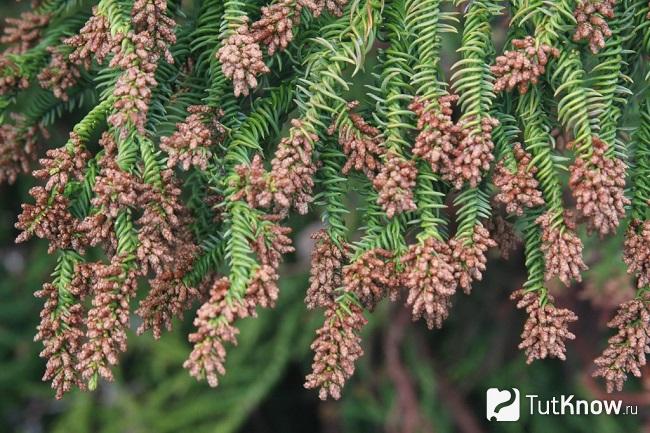

Cryptomeria is considered a fairly ancient representative of the flora, and by the age of 150, its height parameters can reach 60 meters with a trunk diameter of up to two meters.
Cryptomeria is a frequent visitor in the gardens or park areas of Russia, for example, if you take the regions of the Black Sea coast.
Since cryptomeria, like all its "coniferous relatives", has the ability to release phytoncides, the plant will fill the room in which there is negative oxygen ions, and the aroma of the needles will help prevent viral diseases, serving as a natural bactericidal agent, therefore, the development of pathogenic microbes will discontinued.
The main diseases and pests of the plant and methods of their treatment
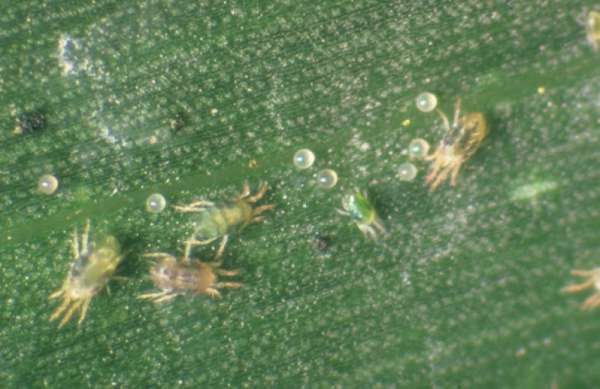

Japanese cedar, like most other conifers, releases phytoncides.
Thanks to them, some pests bypass this plant. But if the air humidity is low, a spider mite may appear on the plant. A systemic insecticide is used against such a pest.
For the prevention of spider mites and needles falling off you need to maintain a sufficient level of humidity (60-80%)
by spraying the plant.
As you can see, Japanese cedar is a fairly simple plant to care for, and even beginner growers can easily grow it at home.
Are you a true connoisseur of beauty, grace and originality? Then Japanese cryptomeria is what you need. This very beautiful evergreen plant came to us from Japan. Under natural conditions, cryptomeria reaches 50-60 meters in height and up to 7 meters in diameter. We are interested in its more compact variety, suitable for growing in homes, offices and winter gardens.
Indoor Japanese cryptomeria is a coniferous tree 1 - 2 meters high, with a compact crown of various shapes and a cylindrical trunk with brownish-red bark. Thin graceful twigs of the plant are covered with light green needles, which have a yellowish tint in winter.
The young needles of the plant are soft, flat, almost straight, the adult needles are hard, subulate, curved at the base. Small bumps of cryptomeria with a diameter of up to 3 cm remain on the tree for a long time even after the seeds have spilled out and give it a special decorative effect.
Conifers are not so frequent guests in our homes: palms, ficuses, flowering plants are more understandable and familiar. However, some difficulties, but rather the subtleties of care, will more than pay off with clean air with a pleasant pine aroma and an awareness of the exclusivity of your interior.
For spacious rooms and offices, the Japanese Elegans form of cryptomeria is best suited. In autumn, the needles of this tree turn reddish or bronze. It is better to grow the “Compacta” form in an apartment, which is distinguished by a pyramidal crown and relatively small size.
Cryptomeria
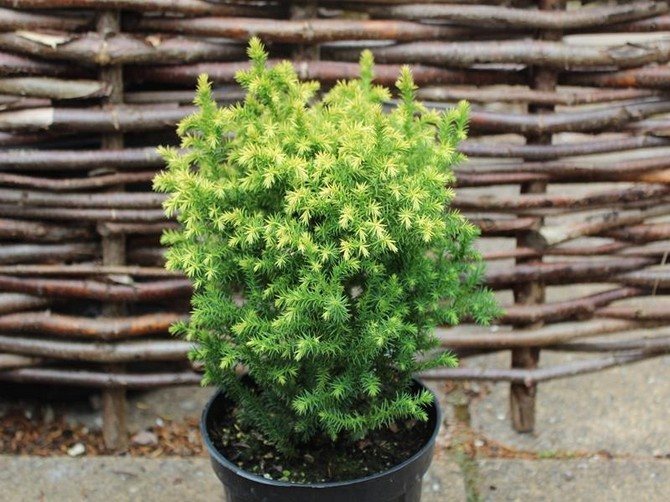

This evergreen ornamental plant can be a decoration of any site, and also act as an element of the decor of a room as a houseplant. True, flower growers and gardeners do not often plant this evergreen tree, since it requires a lot of space on the site, and it will take up a lot of space in the room. Although cliptomeria does not require complex care and does not take much time, but only true lovers of this plant are engaged in its cultivation.
Kliptomeria refers to conifers, or rather to the cypress family. China is considered its homeland, and in Japan the plant is considered sacred and even one of the national Chinese symbols. The plant became popular in Europe after 1840. European landscape designers have appreciated this ephedra and are happy to use it in landscaping areas. For professional designers, this plant is considered an honorable place for its decorative qualities.
In the wild, this evergreen tree can grow up to sixty meters in height, and its trunk can reach two meters in diameter. The upper part of the tree resembles a pyramid, and the shades of the needles shimmer from dark green to bluish.
Cryptomeria care
Caring for cryptomeria is no more difficult than for any other indoor plant, however, it requires adherence to some rules.
Lighting. Cryptomeria does not tolerate direct sunlight, the light must be diffused. It is quite shade-tolerant, but it grows better in good lighting, so in winter it should be placed closer to the window.
Watering. The microclimate of living quarters, unfortunately, is not ideal for conifers, so it is advisable to spray the crown of the plant 1 - 2 times a day. Otherwise, the lack of moisture will manifest itself as yellowing and shedding of the needles. The tree is often watered with a little settled and heated to 20 - 25 ° C water. In summer, watering is done daily, in winter - as needed. The soil should not be allowed to dry out, it is even worse if the water stagnates - the roots will immediately begin to rot and the tree will simply die.
In connection with this cryptomeria, good drainage must be ensured. At the bottom of the pot, or even better a wooden tub, a layer of expanded clay or small pebbles with the addition of charcoal is poured, which will ensure the drain of excess water.
Top dressing. The main thing here is not to overdo it.Top dressing is carried out with a weak solution of mineral fertilizers twice a summer.
Temperature conditions. In winter, the plant needs to lower the temperature to 6 - 12 ° C, which can be very difficult to provide in indoor conditions. At this time, the tree requires increased attention. In addition, cryptomeria does not like stagnant air, so it is necessary to ventilate the room.
Transplant. The young plant is transplanted annually in early spring (March - April) during the period of active growth. The root system cannot be disturbed, so the tree is carefully transferred into a slightly larger container and then fresh soil is poured. An older plant (over five years old) is transplanted every 3-4 years, and in the spring they simply remove the top layer of soil and add fresh soil. You should be aware that a pot that is too large in volume and intensive feeding can provoke an increased growth of cryptomeria.
Growing Cryptomeria
Cryptomeria care is quite difficult, the plant requires daily attention. The miniature size of the plant is achieved by regularly cutting the roots and pinching the tops of the shoots.
Rigid wire is used to give the branches an attractive shape. In order to restrict plant growth, cryptomeria is grown in small low pots - round or rectangular bowls with drainage holes.
Terracotta pots with good moisture exchange properties are ideal. Cryptomeria, like all bonsai, is an amazingly hardy and long-lived plant.
Afraid of direct sunlight and drafts: outdoors, shade and shelter from rain and wind; in the room - do not place near radiators and protect from drafts.
When placed near a light source, it is advisable to periodically rotate the plant in a circle for uniform illumination.
Since cryptomeria belongs to garden bonsai, it thrives best outdoors in a temperature range of +10 - 18 C.
When placed indoors, it is advisable to periodically take the plant out into the open air, ordinary indoor air is too warm and dry for it.
The soil is kept constantly moist, but not waterlogged. Watering plentifully, if necessary - daily or even twice a day.
The formation of a hard crust on the soil can damage the plant. Using a watering can with a nozzle - a sieve will allow watering not only the soil, but also the crown of the plant. Use only warm water, ideally rainwater.
Spraying the leaves every day is an essential part of plant care, especially when grown indoors.
With proper care and the use of special soil, this type of garden bonsai does not need frequent fertilizing with mineral fertilizers.
At the same time, "treating" the soil with fertilizer after plant transplantation activates the growing season. The easiest way is to purchase a special bonsai fertilizer and follow the instructions.
Transplant - in the spring, once every two years. At the same time, the old soil is partially removed, and the roots are cut off by 1/3 of the length. The plant is planted in the old pot filled with new soil.
The plant usually comes on sale from the nursery at a fairly adult 4-year-old age, with an already formed crown and root system. The cost of such a plant is quite high.
Growing cryptomeria at home from scratch will take a lot of time and patience. The stalk of the plant is rooted and planted in a small-diameter pot.
When the plant reaches the desired height: the top is pinched, the lower branches are removed and the ends of the upper lateral branches are cut off.
After 2 years, in the spring, the plant is cut off a third of the length of the roots and transplanted "for permanent residence."
The main pests are scale insects and spider mites. Less commonly, the plant is affected by thrips and whiteflies.In the fight against pests, special chemicals are used, it is also possible to remove insects by hand with a cotton swab or brush.
Poor drainage or improper watering can lead to root rot. Stagnant water in the pot is a breeding ground for the growth of fungi that cause black rot - a disease of the roots of the plant.
When damaged by rot, they replace the soil and treat it with fugicides (for example, benamyl or thiram).
The key to healthy plant roots is balanced watering and optimal growing temperatures.
There are many conifers that will decorate any garden or summer cottage. Among them are the familiar pines and spruces, and more exotic species - for example, Japanese cryptomeria. This tree, considered the national symbol of Japan, is grown both outdoors and in indoor pots as a bonsai. And although it is quite capricious, the difficulties of caring for it are worth it, because in return you can get a wonderful decoration for your home and garden.
Reproduction of cryptomeria
Cryptomeria is propagated by seeds or non-lignified cuttings.
Freshly harvested seeds are sown in a mixture of peat and sand (1: 1). It is better to sow at once piece by piece in separate containers, so as not to disturb the root system too much during transplantation.
Young, non-lignified cuttings are cut with a sharp knife and placed in a container with water for rooting. It is desirable to treat them with heteroauxin to improve root formation. After the roots appear, the cuttings are planted in a mixture of leafy, turfy land and coarse river sand in equal proportions.
Rooted cuttings and seedlings grow rather quickly and begin to bush, which makes it possible to start forming the crown of the future tree.
Japanese cryptomeria is one of the few conifers that can not only exist in room conditions, but not lose their decorative effect. It can be given the freedom to grow or shaped like a bonsai. Some use cryptomeria as a Christmas tree. The phytoncides that this ephedra releases disinfect the air, creating a healthy atmosphere in the house.
In the southern regions, cryptomeria is successfully grown in open ground, in the middle lane only indoor culture is possible - it cannot withstand our frosts below -12 degrees.
Cryptomeria - plant features
Cryptomeria is an evergreen tree with a pyramidal crown. The bark exfoliates in long stripes, it is distinguished by a brown-red color. The buds grow densely, arranged in a spiral in 5 rows, small, consist of three leaves, without scales.
The needles live for about seven years, very tough, five-row, pointed, 15 to 25 mm long, growing in a spiral, yellow-green in summer and dark green in winter. The needles are flattened on the sides, rounded-triangular, the tips are bent inward, stomatal stripes on both sides. Male spikelets at the ends of the shoots are twisted, the stamens are scaly, oval, anther sacs are located on the underside, the pollen has no air sacs.
Female spikelets are located at the end of the shoots and at the base are surrounded by leaves, which also cover and the seed scales are almost completely fused at the base. Each scale may contain from 2 to 5 ovules. Cones are located at the ends of the shoots, clavate or rounded-ovoid. Seeds are triangular, flattened, oblong, have 2 wings.
It grows in China and Japan, withstands a short-term drop in temperature to -28 °, the normal climate is humid subtropical. It grows quickly enough under suitable conditions.
Cryptomeria belongs to exotic types of plants and in our climate requires special care. She loves the sun and warmth, but excessive heat can hurt her a lot. The best growing conditions will be at a constant temperature in a slightly shaded area with well-drained soil.Since the plant is not resistant to prolonged frosts, which are characteristic of our climate, it is customary to plant it in deep ceramic containers that can be placed in the winter garden or outdoors.
Cryptomeria needs regular and abundant watering from spring to autumn, only for the winter you need to reduce the amount of liquid, but complete drying out of the soil is unacceptable. You also need to make sure that excess water does not stagnate at the bottom of the pot. In addition to regular watering, sprinkling should be carried out twice a day. A sure sign of a lack of moisture is yellowing and falling of the needles. Young seedlings can be fed with organic fertilizers twice a month, a large one will be enough once.
Planting cryptomeria
The most suitable time for transplanting is early spring. The potting mix consists of equal parts of turf, deciduous soil, sand and peat.
A layer of small stones is placed at the bottom of the ceramic container to ensure good drainage. Young plants need to be replanted every year, older trees every three years. Reproduction of cryptomeria
Cryptomeria is propagated by cuttings, cuttings or seeds. When propagating by cuttings, only young shoots are used. For the initial formation of the root system, they are left for some time in a container with water. Then they are planted in a proportional mixture of river sand, turf and foliage.
For germination of seeds, a proportional mixture of peat and sand is used.
Certain types of cryptomeria are used to create bonsai. Decorative forms are often used for landscaping parks. The alleys look very nice if these plants are planted along them. Dwarf forms feel good on terraces and balconies, serve as an excellent decoration for a winter garden.
Negative oxygen ions and coniferous aroma create a healing microclimate in the apartment, filling it with the smallest particles of antiviral and bactericidal oils.
Description of cryptomeria


Sometimes cryptomeria is called Japanese cedar for its external resemblance. But from the point of view of biology, this is not true. It belongs to the cypress family and is represented by a single species, Cryptoméria japonica. But she has more than 200 different forms, but few are suitable for home cultivation.
Jindai-Sugi - dwarf appearance, short branches are covered with bright green needles, grows well on a loggia or balcony;
Bandai-Sugi - no more than 2m in height, with different lengths of needles - at the ends of young shoots - up to 15 mm, they are collected in bunches, on old ones - 3 mm, the needles are tough, have a bluish-green color;
Elegans compacta - dwarf form of Cryptomeria Elegans, the crown is squat, flat-rounded, elongated shoots can sometimes die off, the needles are soft bluish-green in summer, in winter they acquire a purple tint;
Nana albospica - a dwarf form with white young shoots was selected during selection, over time the needles turn green, differs in small annual increments, easily burns in the sun.
For bonsai, Elegans compacta is most often used. Suitable for this purpose and Bandai-Sugi, Vilmorin Gold with golden young shoots, slowly growing Vilmoriniana, its needles in winter are painted purple-red.
At home - in China and Japan, most forms of cryptomeria are majestic - trees with a narrow pyramidal crown up to 50 m tall, sometimes it is compared to pins. In dwarf Japanese cypress trees, it can be spherical or squat flat-round.
The trunk of this evergreen plant is covered with reddish bark, the stripes of which are easily peeled off. Small, scaleless buds give life to needle-shaped, subulate leaves with three or four edges and a spiral five-row arrangement. Sitting densely on shoots, green in summer and yellowish in winter, needles can live up to 7 years. They have a slightly curved shape that resembles a sickle.
Male and female flowers of cryptomeria are different:
- the first are located in the leaf axils singly or in bundles if the shoots are young;
- the latter are at the tops of fresh growths one at a time.
The description of cryptomeria will be incomplete, if not to say about its fruits. These are brown, almost round cones no more than 2 cm in diameter. They consist of 30 woody scales in the shape of a wedge and are able to decorate plants for a long time, even when the seeds have already spilled out.
Japanese Cryptomeria - Cryptomeria japonica Don
Monoecious evergreen tree 30-40 (60) m high, with a trunk diameter of up to 200 cm. The crown is narrow pyramidal with a slender cylindrical trunk. The bark of the trunk is brown-red, separated by long stripes.
The needles are three-tetrahedral, subulate, sickle-curved, 6-12 (25) mm long, located on the branches spirally, densely covering them. In winter, the needles are yellowish, in summer they are dark green. Cones are solitary, spherical, 1-3 cm in diameter, woody; ripen in the first year, open after ripening, but remain on the tree even after the seeds fall out. Japanese Cryptomeria (see photo) is a fast-growing, shade-tolerant tree, thanks to which it can create dense plantings. Moisture-loving - needs moist soil and moist air. However, it grows poorly on excessively moist, poorly drained soils, has a depressed appearance on such soils and often dry tops. Reaches the best development on deep moist, clayey, well-drained soils, on moist shaded slopes. Poorly tolerates the presence of lime in the soil. Heat-loving breed, does not tolerate low temperatures -15-18 ° (even short-term). Propagated by seeds, cuttings (from the apical shoots), layering, gives growth from the stump. Garden forms are often propagated by grafting on a typical form. Provides valuable wood.
Spread. Homeland: Japan - from the island of Kyushu to northern Honshu, at an altitude of 200-400 m - and China - in the mountains of the Fokian and Shekiang provinces. In the USSR, in culture, it is widespread on the Black Sea coast of the Caucasus from Tuapse (sanatorium on May 1, 8 km north of Tuapse) to Batumi. It is especially abundant in gardens and parks and shelter plantings in Adjara, as well as in the eastern part of Abkhazia. In the Sochi arboretum at the age of 40 it has a height of 19.5 m, a trunk diameter of 50 cm and a crown diameter of 6X8 m; in Sukhumi, in the Sinop park, at the age of 50 - a height of 28 m, a trunk diameter of 72 cm and a crown diameter of 8X8 m; in Batumi (in the Botanical Garden) at the age of 30 - a height of 30 m, a trunk diameter of 77 cm and a crown diameter of 6X7 m.
Occasionally found in parks on the southern coast of Crimea, but it grows poorly here due to dry air and soil. In Crimea, in Nikitsky Garden, at 60-70 years it has a height of 13 m, a trunk diameter of 31 cm and a crown diameter of 6X8 m; in Alupka (park) at 60 years old it has a height of 14 m, a trunk diameter of 20 cm and a crown diameter of 3X3 M.
It reaches its best development in the warmest and wettest part of the Black Sea coast of the Caucasus - in Adjara. In its northwestern part, it grows much worse. It grows mediocre in Tbilisi.
Of the many forms, the most interesting are the following: elegant - f. elegans Masters (C. elegans Veitch) .- a small tree or shrub with numerous horizontal main branches and very densely branched branches of the second and next orders, forming a very dense crown; the needles are soft, thin, 1-2.5 cm long, more protruding than the typical shape; in summer the needles are fresh-green in the sun, bluish-green in the shade, red-brown in winter; the crown is columnar, as a rule (especially in older specimens), with a significant slope towards the most illuminated side; more drought-resistant, shade-tolerant and frost-resistant than the typical form; tolerates calcareous soil; on the Black Sea coast of the Caucasus reaches a height of 10-15 m at the age of 30-40; this is a juvenile form, fixed and propagated by grafting on a typical form; araucaria - f. araucarioides Henk. - with long, thin, drooping shoots and denser and shorter needles; reminds a.high - Araucaria excelsa; low - f. nana Car - dwarf spherical bush 60-90 cm high, its width is slightly greater than the height; pyramid-T. pyramidata Carr.- with a lush, regular conical crown and upward, densely branched main branches; the needles are very dense, dark blue-green; spiral - f. spiralis S i e b. et Z u with S. - with hanging, serpentine curved shoots and spirally located needles pressed against the shoots; green-T. viridis A. Kolesn. (forma nova) - and in winter it does not change the bright green color of the needles, is in Sochi; golden - f. aurea hort. - with golden yellow needles; silvery terminal - f. argenteo-spicata Be i s s p. - with silvery-white needles at the ends of the shoots.
Application. Japanese K. is a valuable breed for park construction, for field and garden plantings (tea plantations, citrus orchards), as well as for forest crops in the lower and middle mountain zones of the Black Sea coast of the Caucasus from Tuapse to Batumi. On the southern coast of Crimea it is a minor breed , suitable only for planting on non-calcareous soil with watering. Here, an elegant form is more appropriate, as it is more drought-resistant, frost-resistant and tolerant of calcareous soil.In parks, as Japanese, it is advisable to use it on more humid, shaded slopes in groups and alley planting, and its forms - in the form of tapeworms.
Open alleys made of elegant Japanese shape are also very original and decorative. In order for the trunks not to bare and tilt with age, it is necessary to maintain the growth of cryptomeria in height by cutting the top at a height of 4-6 m. Hedges (up to 2 m in height) from this form of cryptomeria are also effective. Unfortunately, this beautiful form is heavily affected by thrips, so it needs careful maintenance.
Many forms of cryptomeria, especially the elegant one, are excellent potting material.
Conditions and care
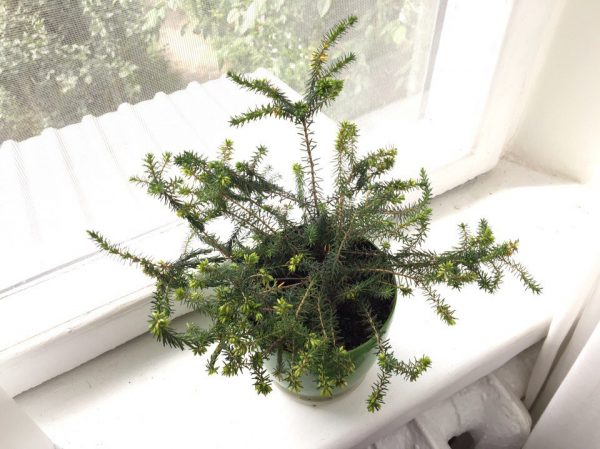

At home, cryptomeria grows in the mountains, where it is not too hot. In dense thickets, diffused light predominates and moisture is well retained. It is these conditions that it is desirable to create a grower for home cryptomeria, so that the plant feels comfortable.
Location and lighting
The main trouble with room cryptomeria, with its incorrect location, is the burning of needles in direct sunlight. She needs a lot of light, but not direct, but diffused.
These conditions are met by windows facing west and east. Cryptomeria feels good against the wall between the two southern windows. It is believed that the plant tolerates partial shade, but the peak of decorativeness can be achieved only with full lighting.
Temperature
Cryptomeria is a southerner, but that doesn't mean she'll be fine in the heat. In the mountains, where the natural range is located, high temperatures are a rare phenomenon. Even in summer, the plant needs moderate heat - from 18 to 22 degrees. Infrequent fluctuations in one direction or another within small limits will not harm cryptomeria. But if in winter the temperature is not reduced to + 6-12 degrees, the well-being of the ephedra will suffer tangible damage up to its death.
The best place for wintering is a bright glazed loggia without direct sunlight. In the summer, you can bring cryptomeria to your garden and place it in the lacy shade of trees.
Air humidity
Home cryptomeria successfully exists only when the air humidity is from 60 to 80%, which usually does not happen in a city apartment. We have to increase it artificially:
- spray the plant twice a day with soft warm water;
- install a humidifier next to it;
- place a pot of cryptomeria on a pallet of damp moss or pebbles.
- Do not place ephedra near a heat source.
The air around cryptomeria should be not only humid, but also fresh, frequent ventilation is encouraged, but without drafts.
The substrate for cryptomeria must be fertile, it must pass and retain moisture well, and not impede the passage of air to the roots.For its preparation, take in equal parts sod land, sand and well-ripened peat.
Cryptomeria is acidophilus. The soil pH value for it should be in the range of 5-6.
The addition of coniferous soil - rotted coniferous litter - will help acidify the substrate. Its amount is determined by the acidity indicators.
Cryptomeria loves water, but fanaticism when watering is inappropriate.
For this plant, the golden mean is suitable - always moderately moist soil.
The frequency of watering cryptomeria depends on many conditions: the temperature of the substrate in the pot and the ambient air, the time of year, the conditions of keeping - in the garden or at home. In winter, it is required to moisten the ephedra less - about 4 times a month, in summer - as the top layer of the soil dries slightly. The water temperature is the same as that of the air surrounding the plant; the presence of calcium salts is not allowed in it. They alkalize the soil, which is unfavorable for the development of ephedra.
For cryptomeria, two feedings per season of active growth are enough. It should take 2 months from transferring to a new pot to the first of them. Mineral fertilizers are used for conifers, the concentration during cultivation is halved against the norm in the instructions.
So that the plant does not show rapid growth, you should not get carried away with fertilizing.
Caring for cryptomeria at home implies its periodic transplant. But it should be annual only for young plants. For a tree over 5 years old, it is enough to replace the upper part of the soil (5 cm). This should be done annually.
An adult ephedra is transplanted no more than once every 4 years in early spring.
The plant suffers very painfully damage to the root system, so it is simply transferred into a new pot, completely preserving the earthen lump. The number of sprays then increases.
It is impossible to greatly increase the size of the pot, this will provoke a rapid increase in cryptomeria.
When preparing the plant for transplantation, drainage is arranged in a new pot.
Cooking use
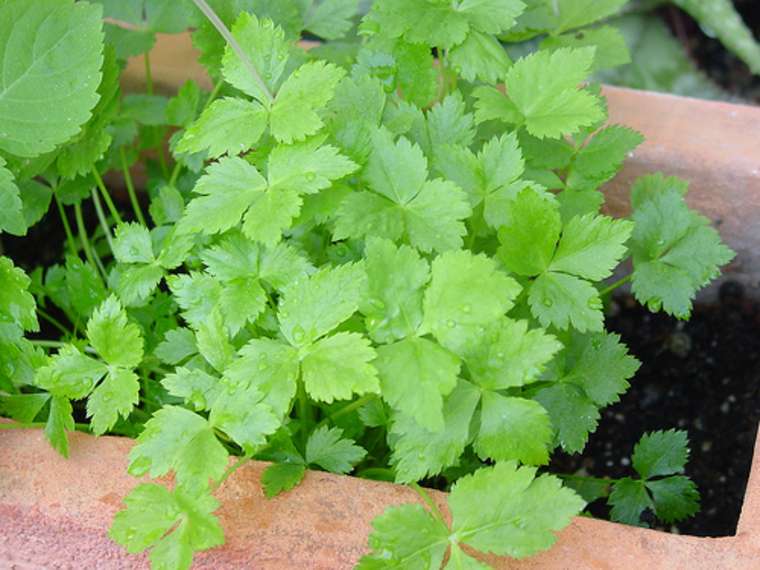

The softness of the aroma of Tripoli is reminiscent of a celery scent. The wayward spice tastes sweet. Stimulates appetite, invigorates and tones up. In the land of the rising sun, roots, twigs and leaves are used to flavor potatoes and soups, rice and rolls, as well as to bake with vegetables. Suitable as a side dish for seafood.
Stem, seeds are consumed raw. Sprouts are usually added to salads. It is not customary to subject it to prolonged cooking heat treatment: the taste changes to bitter, the nutritional value decreases.
It is used as a spicy culture in the recipe for the national Japanese food tempura. Leaves and bleached sheets are good for burgers and sandwiches. They are also boiled, stewed and fried. The seeds are used as a spice.
The roots of Japanese Cryptotenia are used in the diet, during cooking they are stewed or boiled. Often they become an independent dish that can be consumed as a separate dish or in conjunction with other prepared foods. Mostly with fish or meat.
A distinctive feature of Mitsuba: being a perennial plant, it pleases with greenery in early spring.
Consumption in large quantities is harmful to health, causes irritation of the skin. For gastronomic purposes, it is grown in an annual plant.
Kakiage with vegetables
Components:
- half of the head - onion;
- 3 tbsp. l. - water;
- 60 g - ginger root;
- 1 bunch - Mitsuba;
- 0.2 tbsp - wheat flour;
- 1.5 tbsp. l. - potato starch;
- 300 ml - sunflower oil.
Cooking technology:
- Cut the onion and the Lurker into strips.
- Stir in ginger with vegetables. Add starch, flour and cold water.
- Heat oil and fry until golden brown. Place on paper napkin.
- Wait for the oil to drain. Serve with soy sauce.
Reproduction
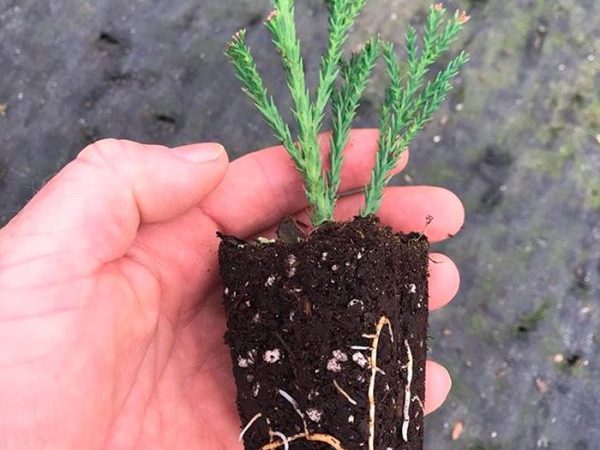

For cryptomeria, both vegetative and seed reproduction is possible, it is fraught with some difficulties.
The propagation of cryptomeria by seeds is a long process. It is complicated by the fact that their germination rate is rapidly falling within the first year after collection. In this case, one cannot do without stratification. Experienced flower growers advise to carry it out in a natural way: sow it in a container before winter and leave it outside for the winter. After the snow melts, it is placed on the windowsill in the room. For germination, a soil temperature of at least 25 degrees is required. But in this case, seedlings will have to wait about 1.5 months. All this time, the soil in the container is sprayed with warm water, preventing it from drying out.
The best time for grafting is July or August. For these purposes, both apical and axillary non-lignified growths are suitable. The cut stalk is treated with a rooting stimulator and planted obliquely in calcined sand under a glass or plastic bag.
- before winter the temperature is from 16 to 18;
- in winter - 6-12 degrees;
- from mid-February - temperature as in autumn;
- diffused but bright light;
- moderately moist soil;
- frequent spraying.
In April, it is already possible to plant rooted plants.
Success secrets
To grow a beautiful Japanese cedar at home, you need to follow these steps:
- create cool conditions of detention. The optimum temperature for cryptomeria is up to +15 C all year round;
- the plant loves dim and diffused light. Shade also tolerates;
- moisturize the tree moderately as the top layer of the earth dries up;
- it is preferable to moisten the culture with soft and filtered water;
- needles like high humidity. Therefore, regular spraying is carried out;
- in the spring and with the onset of autumn, a little mineral dressing is added to the water for irrigation.
And lastly, in order for the crown to have a beautiful shape, it needs to be shaped. The green mass is pruned 2 times a year. This will help achieve a neat appearance of the tree.
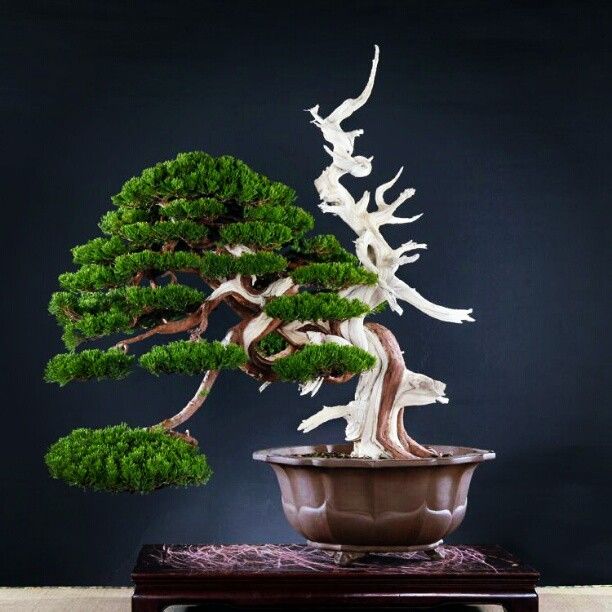

Cryptomeria are a wonderful home decoration. However, this tree is also useful. The green mass releases phytoncides into the air, eliminating bacteria and viruses, and also fills the air with a delicate coniferous aroma.
Diseases and pests
If the needles of cryptomeria darken or turn yellow, and the shoots die off, the cause is a fungal infection. You cannot hesitate with treatment:
- they revise the roots, for which the plant is taken out of the pot, all the blackened ones are cut off, the cuts are covered with crushed coal or colloidal sulfur;
- the ephedra is planted in a disinfected container, disinfecting the soil;
- water the soil with a solution of phytosporin (dilute according to the instructions), they also spray the green parts of the plant and the trunk;
- processing must be repeated weekly up to 5 times.
Pests are not overly fond of cryptomeria. They are scared off by phytoncides secreted by the tree. Sometimes a mealybug settles on it, similar to tiny pieces of cotton wool. Treatment with a solution of "Fozolon" 0.2% concentration will help.
Spread
The natural environment for growing needles is the territory of China and Japan. Pure stands are formed in the mountains. In Russia, cryptomeria is found on the Black Sea coast. The "green beauty" grows in parks and gardens. Under natural habitat conditions, the culture can grow up to 50 meters. Such varieties are not used in landscape design. For growing bonsai, dwarf subspecies are chosen.
The trunk of the tree is covered with reddish fibrous bark. Cryptomeria is always green, dense and not prickly. Small needles are arranged in a spiral. After formation, the needles last for 5 years. Then it's time to change them. The crown can be easily formed and retains its shape for a long time.
The culture purifies the indoor air, is not pretentious about lighting, and is ideal for decorating living and office rooms. In natural habitat, it lives for more than 300 years.And due to its high resistance to decay, wood is used in the manufacture of various decorative elements.
Growing problems
If you exclude fungal diseases, the remaining problems in the cultivation of cryptomeria are associated with improper care:
- intensive feeding and too large a pot provoke rapid growth, which is undesirable in an apartment;
- watering with hard water causes alkalization of the soil and, as a result, a lack of certain nutrients, which slows down the development of cryptomeria;
- insufficiently humid air dries up the needles, it will begin to turn yellow and fall off, poor watering and burns with direct sunlight lead to this;
- abundant moisture is a path to the development of fungal diseases, the root system of cryptomeria can rot;
- non-observance of the temperature regime and the absence of a cool wintering can cause the death of the ephedra.
With proper care, the tree is not susceptible to diseases or pests.
Beneficial features


The chemical composition of trifol contains:
- mono - and disaccharides;
- essential oils;
- vitamins: C, A, B6, B2, B1, B9, PP, E;
- fiber;
- minerals: calcium and iron; retinol and phosphorus; potassium and magnesium; sodium.
The composition of the culture includes:
- proteins - 2.3%;
- carbohydrates - 4.4%;
- fat - 0.23%.
There are 13 kcal per 100 g of Japanese Skylark's raw materials.
Japanese cryptotenia has the effect of:
- tonic and antioxidant;
- antiseptic and antimicrobial;
- anti-cancer and anti-mutagenic;
- expectorant and hypolipidemic;
- antifebrile.
Japanese parsley has found applications in alternative medicine:
- fights colds, coughs and bronchopneumonia;
- resists prostate adenoma and strokes;
- resolves urinary problems;
- fights diabetes and neoplasms;
- inhibits chronic inflammation and protects against autoimmune diseases;
- heals rashes on the epidermis;
- reduces lipid content.
In the treatment of bee and snake stings, Mitsuba leaves are used.
In traditional medicine in China, it is called Ya Er Qin.
Transplant timing and technology
Japanese home cryptomeria reacts poorly to transplantation, it experiences stress and then recovers for a long time. This manipulation should be performed once every five years.
Algorithm of actions:
- Prepare a larger diameter flower vessel.
- Fill with fertile soil, laying drainage at the bottom.
- Make transshipment of ephedra together with an earthen clod, fill the voids with soil.
- Water the plant.
Adult plantings are not transplanted in this way, it is enough just to replace the top layer of the soil substrate. Frequent transplantation for Japanese cedar is undesirable: its roots are distinguished by a high degree of sensitivity and, sensing free space, begin to actively grow.
Elegance Viridis variety
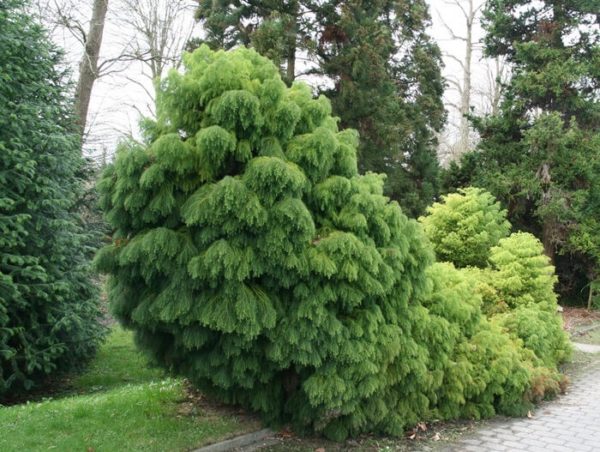

Cryptomeria Elegance Viridis is a monoecious, evergreen tree. In its natural environment, it rarely grows more than 6-7 meters. The crown is narrow pyramidal, the trunk is bent and curved. The branches are short, densely spaced and highly branched. The needles are soft, thin, green in summer, and bronze or purple in the autumn-winter period. Bumps are rare.
Grows well in moist soils. The variety is shade-tolerant and sensitive to lack of air humidity. Therefore, regular watering is necessary.
Care
Cryptomeria room care. The plant prefers to be in the light, but not in direct sunlight. In winter, cryptomeria can be placed by the window, since the sun ceases to be too bright, and cryptomeria needs lighting.
For cryptomeria, it is necessary to provide a low temperature. In summer, it should be 14-15 degrees, in winter - 8-12 degrees. The plant needs fresh air, but drafts should be avoided.
Watering.
For the plant, you need to provide a constantly moist soil, but in winter it is possible to allow a slight drying of the top layer. The plant should not be poured; it is better to water in small portions more often.Cryptomeria loves spraying with soft water, especially in hot weather.
Top dressing
carried out in the spring-summer period with fertilizer for indoor plants. It will be enough to use a weak fertilizer solution twice a month. You can use other fertilizers, alternating with organic ones.
Plant transplant.
Until the tree has reached a large size, transplanting can be done every year, each time slightly increasing the pot. Large trees need replanting every 4-5 years, but they need to renew the topsoil every year. When transplanting cryptomeria, good drainage must be ensured. It is not advisable to use ceramic pots, since lime accumulates on their walls over time, which has a detrimental effect on the plant. It is also good to add coniferous soil to the soil (it is formed by humus of bark and needles).
It is thermophilic: -15 ° С for it is already a critical winter minimum, therefore, for the first 3 years after planting on the South Coast and the Black Sea coast of the Krasnodar Territory, the soil around the metasequoia is mulched with humus. When planting, a stake is set and tied (eight) with a soft twine to a tree to a support. It develops better in sunny locations and constantly wet, but without stagnant water, fertile soils, so it is very important to ensure regular watering in the first 3 years. It tolerates transplantation, summer drought, but autumn watering is necessary. Every year in the spring, at the beginning of the growth of shoots, they are fed with a special fertilizer for conifers. If necessary, carry out sanitary pruning and remove (as it appears) near-stem shoots. Propagated by freshly harvested seeds (soil germination up to 30%, seeding depth 1-2 cm) and vegetatively - by cuttings.
It is interesting:
- Glyptostrobiform metasequoia was discovered in the mountainous regions of central China, first in a fossil state - in 1941, growing in nature - in 1944, in culture - since 1947, in Russia - since 1950, in the Nikitsky Botanical Garden - since 1950 of the last century ...
- This is a rare species of the world dendroflora.
- In China, metasequoia is called water fir
, as it grows along the banks of mountain streams, and in the UK -
mahogany dawn
or
blood red tree
(Dawn redwood). - Glyptostrobiform metasequoia is the fastest growing coniferous tree on the planet, with an annual growth of up to 1.0 m!
- It is a branchy tree, in which the summer growth (shortened shoots) falls off in the fall like leaves.
Why does cryptomeria needles turn yellow and fall off?
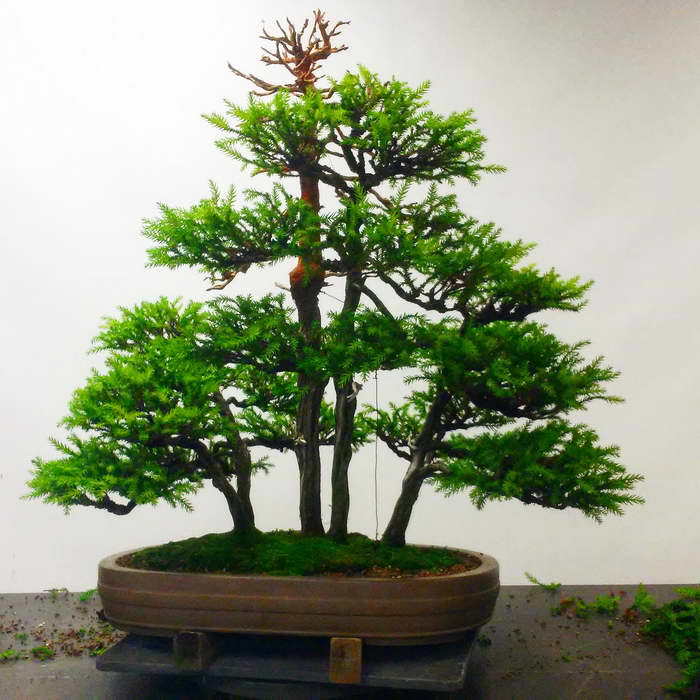

Why does cryptomeria needles fall off? Photo of a sick plant
Japanese cryptomeria, releasing essential oils, not only purifies the air, but also protects itself from pests and diseases.
The condition of the plant worsens with mistakes in care:
- The needles turn yellow in too bright light. Do not place on the south side, direct sunlight is contraindicated;
- The needles fall off if the air in the room is dry. It is necessary to regularly spray the plant even in winter. Under no circumstances place the charming sugi near working batteries and heating devices;
- Excessive watering combined with high air temperatures leads to rotting of the root system. An emergency transplant will be required with the removal of the affected areas and the replacement of the substrate. You will have to trim the roots, which are very susceptible to damage and may not recover. Water sparingly to prevent this from happening;
- Inspect twigs and needles regularly for early detection of pests. Scabbards or spider mites appear occasionally. It is necessary to carry out treatment with an insecticidal preparation (topa Bi-58, Aktara).
Diseases of cryptomeria


Infectious lesion of cryptomeria photo
Over-watering Japanese cedar can get fungal infections. This will manifest itself in yellowing, darkening of the needles and the death of branches. Moreover, this phenomenon is quite rapid, so it is absolutely impossible to delay treatment.Even with appropriate measures, the plant can die.
Rescue measures for dying cryptomeria:
- Cut off all damaged parts of the plant: dry and yellowed branches.
- Remove the plant from the pot, carefully remove the soil from the roots, inspect carefully and cut off any rotten parts.
- Transplant into fresh soil (be sure to do drainage), disinfect the pot with a solution of potassium permanganate or boiling water.
- After transplanting, water the plant with a solution of phytosporin, and also treat it along the needles and branches from a spray bottle.
- After transplanting, place in a place where there will be diffused lighting.
- Treat with phytosporin or other fungicide at intervals of 7-10 days 4-5 times.
Even a recovered tree will need to be regularly examined and treated with a fungicide at the slightest sign of illness.
Necessary conditions for growing
In order for a houseplant with a compact crown size to grow and develop normally, it is necessary to create favorable conditions for growth. When growing Japanese cedar in the form of bonsai, you need to provide a sufficient amount of light, moisture and do not forget to periodically add nutrient mixtures.
Location and lighting
In order to avoid possible problems in the future, cryptomeria, like a light-loving ephedra, should be on the windowsill of the western or eastern windows. It also grows well in the space between the windows on the south side of the room. If the pot with a houseplant is in the shade, then the color of the needles will not be as pronounced and attractive.
The optimum room temperature for an exotic guest is between 18-25 degrees. To create a dormant period, the temperature in the room is lowered to 12-13 degrees.
Air humidity
Considering that a coniferous evergreen plant in the wild grows in a humid climate, then at home it needs to create as close as possible to its natural environment. The humidity level in the room should be high enough - from 50%. In summer, it is recommended to frequently spray the bonsai and place it on a pallet with damp expanded clay. Particular attention should be paid to ventilation, air stagnation should not be allowed. But through winds are also not needed. The dry microclimate has a detrimental effect not only on the color of the needles, but also on their general condition.
Soil requirements
To get a truly luxurious evergreen decoration for your home, you need to properly prepare the soil. It should consist of river sand, turf and leafy land, where all components are taken in equal proportions. Coniferous soil added to the soil, consisting of humus bark and needles from conifers, has a very beneficial effect. Only fertile, light and loose soil is capable of providing everything an exotic ephedra needs.
Possible problems
The main problem with cryptomeria is drying of branches
and
needle fall
, is caused by pathogenic fungi attacking patients with weakened cryptomeria.
Damaged branches
cut and burned, plants are treated with fungicide solutions containing copper (copper sulfate, copper sulfate).
Contents of the article: Cryptomeria or as it is also called Japanese Cryptomeria japonica is an evergreen tree-like plant that goes into the Cypress family (Cupressaceae). There is only one variety in the genus and is popularly called the Japanese cedar. In Japan, this representative of the handicap is considered the national tree.
In China, this plant is called Shan, and in Japanese lands, Sugi, these two terms have almost everywhere replaced the old aforementioned name, since cryptomeria itself has nothing to do with the genus Cedrus and its name is considered erroneous.
From the foregoing, we can conclude that the plant is endemic to the territories of Japan and China, that is, it does not germinate in the wild anywhere else on the planet.And in those areas in the mountainous regions of Sugi, it successfully forms clean plantations. On the Russian lands, only on the island of Kunashir, cryptomeria is represented by one single specimen. And that is why botanical scientists put forward the assumption about the introduction of this tree, that is, that it was intentionally or accidentally transferred from its native territories.
In height, Japanese Cryptomeria can reach 50 meters, it has a dense and narrowed crown, almost pyramidal. The trunk is covered with a bark of a reddish-brown color, fibrous, which can slide in stripes. The contours of the barrel are cylindrical. Gnarled branches are spaced from the trunk. There are small-sized buds, their appearance is not scaly. The arrangement of the leaf plates is spiral in five rows, while they are directed forward with a bend inward. The leaf takes a linear-subulate or needle-like shape, with a curvature at the base, there is compression on the sides, the leaf is obtuse in section, with three or four edges, monoecious, their color is from light greenish to dark green. The size of the needles fluctuates about 2.5 cm. In winter, in some forms, the needles can take on a reddish or yellowish color. A needle can function on a knot for up to 7 years.
During flowering, female and male flowers are formed. In females, the shape is rounded, the arrangement is single, such buds crown the ends of young shoots. Male ones are also formed singly, on young branches, while bundles are collected from them. They are covered with covering scales that start from the bottom and go to the middle, growing together with the seed scales.
The contours of the seed cones are almost spherical, they can reach 2 cm in diameter, their color is brownish, they are located singly, ripening in the first year, and can remain on the branches even after the seeds are scattered. They have scales, the number of which varies in the range of 20-30 units, their shape is wedge-shaped, they are woody, they have three cotyledons (sometimes x-11).
Shan is used for landscape gardening. Despite the rather impressive type of cryptomeria, dwarf forms have already been bred, which are successfully grown in indoor conditions. This plant has been in culture since 1842.
- Lighting and site selection.
Most of all, for growing Japanese cedar, bright lighting is suitable, but with diffused sunlight. This can be achieved by placing a pot of cryptomeria on the sills of east or west windows. If there is no way out, and the plant is on the south window, then it is imperative to shade the direct streams of midday ultraviolet radiation with curtains made of light fabrics. On the north - you will need to carry out illumination with phytolamps. - Content temperature.
In summer, it is recommended for cryptomeria to carry out frequent airing and it is desirable that the heat indicators do not rise above 25 degrees, but with the arrival of winter it is important for the plant to lower the temperature to 5-12 units, since without such cool conditions the Japanese cedar will be tight. In the summer, you can take the plant out into the open air; for this, a balcony or terrace is suitable, where the windows will be open or a place in the garden. - Air humidity.
The humidity indicators in the room where the plant is located should be in the range of 60-80%. When cultivating cryptomeria, it is required to spray the crown of the tree 1-2 times a day, since the Japanese cedar is very sensitive to dry air. You will need to increase the humidity level by various methods: by installing air humidifiers next to the pot, you can put the flowerpot in a pallet with a small amount of water poured and poured with expanded clay or pebbles, the simplest method is to install a vessel with water next to the cryptomeria. Regular ventilation is also recommended. - Watering cryptomeria.
Moisten the soil in a pot with Japanese cedar often, but in small portions. Water is used only soft, heated to 20-25 degrees.In the spring-summer period, such watering is daily, but with the arrival of winter, this operation is carried out as needed, and depends on the wintering conditions. It is important not to allow both liquid stagnation (this will lead to decay of the root system) and the complete drying of the earthy coma (the needles will begin to turn yellow and fall off). If the plant hibernates in cool conditions, then watering can be halved. - Fertilizers
for Japanese cedar it is applied every 3-4 weeks, from May days to early autumn. It is important not to overfeed cryptomeria, as there will be an explosion of its growth. The main thing is that the dressings do not contain a large amount of nitrogen in their composition. It is recommended to use liquid formulations of mineral fertilizers. However, if a transplant has been carried out, then in the next year such a plant does not need to be fertilized. - Cryptomeria transplant.
While the plant is young (up to five years old), it needs annual changes of the pot to a larger one, and the soil in it also changes. The time is selected in March-April, until the Japanese cedar began to actively develop. But it must be remembered that frequent transplants and too much increase in the size of the pot will lead to an increase in the growth rate and soon cryptomeria can turn into a real tree. When transplanting, it is better to use the transshipment method when the earthen lump is not destroyed, since the root system is quite sensitive. If the tree is already large, then you can transplant every 3-4 years, and the rest of the time you can change the top layer of soil (4-5 cm) to a fresh one. A layer of drainage material is necessarily placed on the bottom of the new pot (medium-sized expanded clay or pebbles, you can take broken ceramic or clay shards or crushed brick).
The substrate should be loose, cryptomeria grows well on acidic soils, the reaction to lime is negative. Usually the soil is composed of leafy soil, compost and coarse sand, everything is taken in equal parts.
After the plant has been transplanted, its crown is abundantly sprayed during the first few days, 2-4 times.
You can get a new young Japanese cedar plant by sowing seeds or using cuttings and layering.
Freshly harvested seed material must be placed one unit at a time in cups with peat-sandy substrate (proportion 1: 1). Covering the container with a plastic bag, it is placed in a warm place with shade from direct sunlight. It is necessary to carry out daily ventilation and, if necessary, spraying the soil. The seeds will hatch in 2-3 weeks.
But the most successful is the grafting method. A non-lignified branch (young shoot) is selected and a workpiece is cut from it with a sharpened and disinfected knife into a cutting of at least 10 cm in length. It is recommended to treat the cut with a rooting stimulator (for example, heteroauxin or "Kornevin") and the branch is placed in a vessel with water.
When root shoots appear on the handle, planting can be carried out in separate pots. A dredge mixture of leaf and sod soil, river sand and peat (proportion 2: 1: 1: 2) is used, or a substrate based on sod, leafy soil and coarse-grain sand is used (parts are equal). A drainage layer is needed at the bottom of the pot so that the water does not stagnate.
If reproduction is carried out with the help of layering, then the lower shoot should be bent to the ground, having previously cut it a little. At the ground, such a branch is pressed and fixed, covered with soil so that only the tip of the shoot sticks out of it. After a month, such a layer gives roots and successfully takes root, forming its own shoots. Then a separation from the mother plant of cryptomeria is carried out.
Both seedlings and rooted cuttings and cuttings grow at high speed and begin to bush, so crown molding can be carried out even on a small tree.The first five years, transplants are needed in the spring in a larger pot, and then such an operation will be required with regularity after 3-4 years.
Where to put cryptomeria
Japanese cryptomeria is photophilous. Stick to diffused lighting levels, direct sunlight can burn delicate needles. Slight shading is allowed, but it is better to grow in bright enough light. For example, in a room, a plant can be placed in a wall between windows.
In the garden, we choose a place where direct sunlight will fall only in the afternoon. The needles can also fade from the winter sun, we recommend using reflective screens.
Landing conditions
Cryptomeria are more capricious to care for than cedars or pines. They must be protected from winds and too hot sunlight, and ensure good drainage. For planting, you should choose areas with fertile slightly acidified soils. It is contraindicated to plant trees on limestone, in places where there is stagnation of water.


In regions where winter temperatures drop below + 8 ° C, seedlings are grown in pots or tubs, placed on warm loggias, in winter gardens. To contain overgrowth, small ceramic containers are selected. A thick layer of drainage from stones or sand is laid at the bottom. A soil mixture of peat, garden leaf and sod soil is poured on top. The roots of the plant are placed in a straightened form and covered with earth, then watered. Exposing the pots to the open air during the spring and summer is helpful, especially in humid, warm weather.
Sequoia evergreen
Evergreen sequoia (Sequoia sempervirens) is a majestic tree up to 112 m high and 6-9 m wide with a conical crown and red-brown bark.
She is originally from the USA. The needles are flattened-needle-shaped, similar to yew, appressed, scaly, shiny, 2 cm long. Cones (female) spherical or oval, reddish-brown, 2-3 cm long; ripen in September.
Features of growing in the open field
Prefers deep, fertile, moderately moist, neutral soils and sunny locations; in youth tolerates shading. On the South Coast, it grows well on calcareous soils. Propagated by freshly harvested seeds (soil germination is low - 2-16%) and cuttings, preferably from near-stem shoots. Planting material is preferably grown in containers.
It is interesting:
- For the first time evergreen sequoia forests were discovered by Europeans in 1769 on the Pacific coast. Seeing the reddish color of the wood, they began to be called red trees
(Redwood).
- In 1847, the sequoia got its name in honor of the Sequoyah - the leader of the Iroquois (1770-1843), who gave the tribe the alphabet; isolated as an independent genus by the Austrian botanist Stefan Endlicher.
- This is a long-lived tree: specimens are known that are more than 4000 years old. The oldest evergreen sequoia on the South Coast has been growing since 1887 (the year of planting) on a curtain of 16; now it is 32.5 m high and 18 m wide (crown projection).
Are you familiar with taxodia plants? Have you ever been tempted by this coniferous exotic in garden centers?
If you are interested in the fascinating and diverse world of conifers, this selection will certainly come in handy.
This evergreen ornamental plant can be a decoration of any site, and also act as an element of room decor as a houseplant. True, flower growers and gardeners do not often plant this evergreen tree, since it requires a lot of space on the site, and it will take up a lot of space in the room. Although cliptomeria does not require complex care and does not take much time, but only true lovers of this plant are engaged in its cultivation.
Kliptomeria refers to conifers, or rather to the cypress family. China is considered its homeland, and in Japan the plant is considered sacred and even one of the national Chinese symbols. The plant became popular in Europe after 1840.European landscape designers have appreciated this ephedra and are happy to use it in landscaping areas. For professional designers, this plant is considered an honorable place for its decorative qualities.
In the wild, this evergreen tree can grow up to sixty meters in height, and its trunk can be up to two meters in diameter. The upper part of the tree resembles a pyramid, and the shades of the needles shimmer from dark green to bluish.
Kliptomeria is widespread throughout the world and has about two hundred species. In this large family, all monoecious plants have an unusual and remarkable shape. To some, this ephedra resembles an elegant pyramid, and to someone - a sports skittle. All species of this evergreen like to grow in acidic and moist soils. They feel great in well-lit and sunny areas, they are unpretentious in care.
Elegans
- this breed belongs to a slow-growing species. She has fully adapted to urban conditions and different climates. This species is not only frost-resistant, but also able to grow in arid conditions. He is not afraid of city dust and smoke. Practically nothing can affect its decorative qualities and development. This type of tree can even be planted in partial shade areas.
Throughout the year, the color of the needles pleases with different colors. In summer, it turns brown-green, and in winter, coniferous branches delight the eye with green-purple and bronze-red tints.
Vilmoriniana
Is a dwarf breed. This type is often preferred by gardeners, since the plant does not take up much space on the site, but decorates it perfectly. In winter, the decorative qualities of the plant are especially noticeable. The reddish-lilac shade of the needles stands out from the rest of the plants. This short beauty grows no more than four centimeters in height during the year.
Bandai-sugi
- This breed is well known to European gardeners and landscape designers. Such dwarf trees have sprawling coniferous branches of a bluish-green hue.
"Golden" - this breed is often used as a decoration of the site. Young shoots of this species are a real decoration, as they have a golden yellow color.
Among the large number of breeds, there are the most adapted to cold climates, especially winter-hardy species - Globosa nana, Lobbi, Jindai sugi
.
Kliptomeria is a valuable tree species that is actively used in landscape gardening. Japanese breeders use certain species of this plant to breed new dwarf and miniature subspecies.
These coniferous forest giants, thanks to the fruitful work of breeders, can now be found as decor in recreation areas. Wild species of cryptomeria have long been a decorative ornament in alleys, gardens and parks. They are also used as forest shelter belts.
In many public places, such dwarf evergreen trees are an unusual addition to flower beds. If you plant them in a checkerboard pattern along the alley, then from a distance the plants will look like a rich single dense composition.
Only a small number of kliptomeria breeds are frost-hardy. Most species of this plant will not be able to survive the harsh winter cold. The best place for their growth and development is the countries of the Black Sea coast and the Caucasus. In these lands, this evergreen plant feels most comfortable.
But for true lovers and connoisseurs of this coniferous plant, no climate is an obstacle. After all, it can be grown in indoor conditions. Indoors, the tree also grows well, it can reach a height of about two meters. The plant looks compact and very attractive.
Dwarf breeds can be placed not only indoors, but also on the balcony, loggia, outdoor terrace, in the winter garden. The trees are planted in ordinary wooden tubs.And in order to slightly restrain the ephedra in growth, it is enough to reduce the number of dressings and transplants to a minimum.
Indoor cliptomeria has many beneficial properties. The plant gives off not only a pleasant, but also a healing coniferous aroma. The oils it contains have bactericidal and antiviral properties. A favorable and salubrious microclimate is created in the whole room where kliptomeria grows.
Light and location
In indoor conditions, the plant needs to choose a place that is not exposed to direct sunlight, but there should be enough light. Usually such a place can be a partition between the windows. The ephedra will perfectly fit into the home interior, and will receive light in the required amount.
Temperature
For this plant, temperature and air exchange are of great importance. In the warm season, it is advisable to be outdoors for kliptomeria. But in the rest, cool and cold months, it is very important to often ventilate the room. Stagnant air can harm the plant and even lead to death. In winter, high temperatures are contraindicated for this coniferous plant. Even the room temperature is not suitable, the ideal would be no more than twelve degrees Celsius.
Watering and feeding
Both overdrying of the soil and its waterlogging are absolutely equally harmful for this coniferous plant. Having proper drainage during planting and moderate watering will help maintain the middle ground. Spraying is mandatory (at least twice a day with water heated to twenty degrees) and high humidity in the room. Dry air in a room is a negative factor for plant development.
Feeding a houseplant needs minimal. Fertilizers are applied in summer, no more than two times.
Transfer
Frequent transplantation of room cliptomeria can lead to rapid plant growth. In a short time, it will turn from a compact plant into a real tree. Yes, it is better once again and do not disturb the sensitive root system. It is enough just to replace the topsoil.
Reproduction
Experienced breeders and flower growers use the seed propagation method. For beginner plant lovers, it is better to use the cuttings propagation method. The young stalk must be carefully cut and placed in a container with water. As soon as young roots appear, the plant is ready for planting. Cuttings take root well and grow.
Origin. Japan and China.
Description
... Japanese cryptomeria is a coniferous, evergreen, elegant tree with blue-green, green or even burgundy, fragrant needles 1.5-2.5 cm long. Varieties with white needles at the ends of the branches are bred. The trunk of the tree is covered with reddish-brown bark, which can flake off in long, vertical stripes. Unlike most conifers, this species has soft needles that densely cover the branches in a spiral. Mature trees have an attractive pyramidal or conical shape. Cones appear on the tips of branches, small - up to 3 cm in diameter and up to 5 cm long.
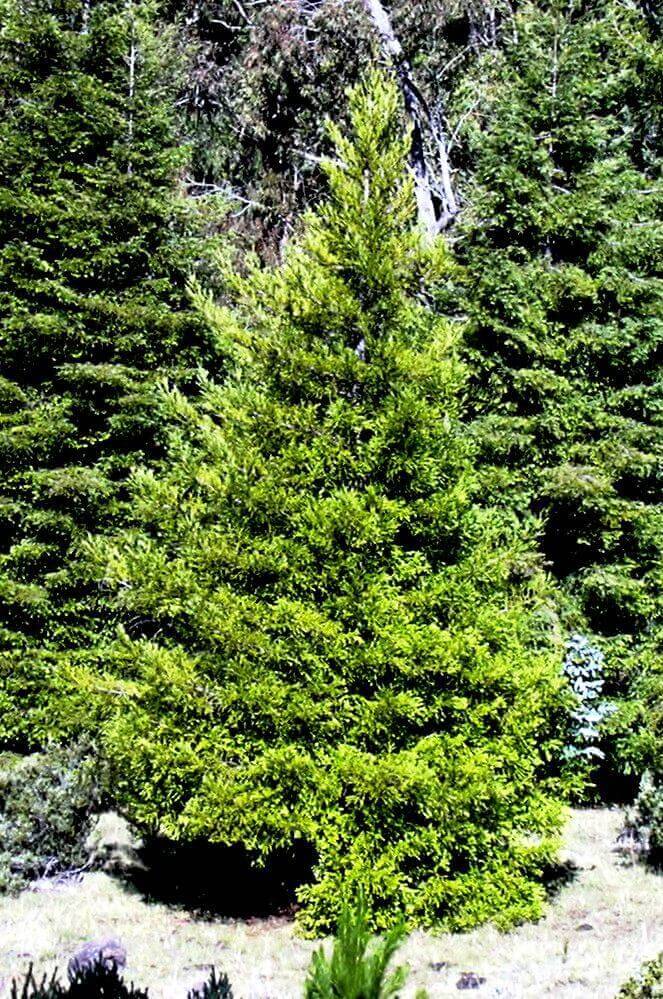

Height
... Under natural conditions, it is very tall trees - up to 70 m, when grown in culture, it rarely exceeds 2 m.
Botanical description and characteristics of the plant
Japanese cryptomeria (lat. Cryptomeria japonica), Japanese cedar is an evergreen coniferous plant of the Cypress family. In the natural environment, Japanese cryptomeria is common in the subtropical regions of China and Japan. In the land of the rising sun, the tree is a national symbol, and therefore, it is found under the name Japanese cedar, although it has nothing to do with the genus Cedar. The Japanese themselves call the plant "sugi", and in China it bears the name "shan". Whatever you call cryptomeria, this does not detract from its majestic beauty.
A giant on a windowsill?
Having met cryptomeria in the vastness of a wild forest, it is difficult to imagine that it is able to settle in a garden, and even more so on a windowsill.This is by no means related to the difficulties of growing and care.
Similar thoughts evoke the impressive size of the tree:
- The straight trunk tends up to a height of 60 meters. The colorful fibrous bark has a reddish-brown hue.
- The trunk can hardly be grasped by one person - its diameter reaches about 2 meters.
Garden cryptomeries are limited to a height of 2-3 meters. The bred decorative varieties of Japanese cryptomeria make it possible to form even miniature trees (bonsai) in room conditions.
Of course, the owners of garden plots value every square meter and try to grow more fruit and berry crops. But the picturesqueness of the plant does not leave you indifferent. There are similarities with the araucaria. Crown of pyramidal cryptomeria. The needles are soft to the touch. Three-, four-sided needles of an emerald shade, on the shoots is located in a spiral shape. Brown fruit-cones remain on the plant for a long time, even after shedding the seeds.
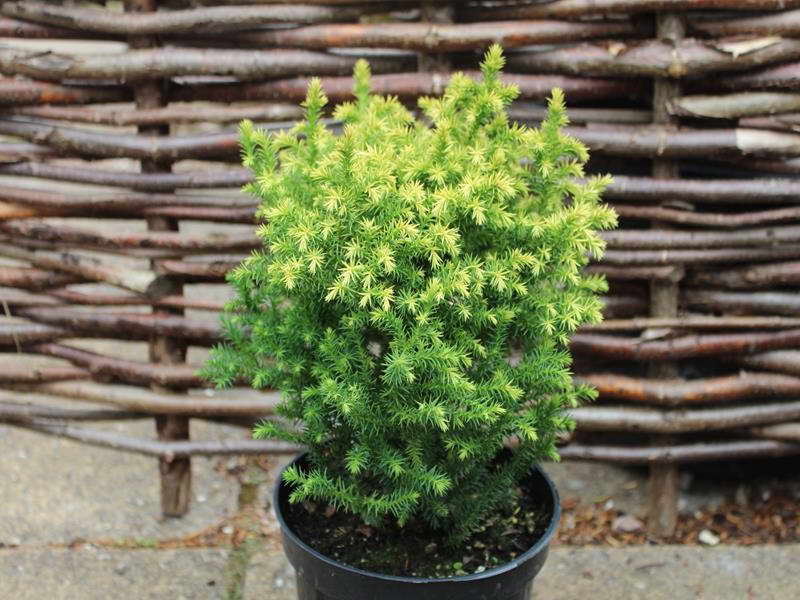

Cryptomeria Japanese variety Cryptomeria japonica ‘Golden Promise’ photo
The thermophilic cryptomeria was introduced to Europe back in 1842. In the open field, it is cultivated only in the south (Black Sea coast, Caucasus), where it has become an irreplaceable adornment of parks and gardens. Even a long growing period did not help to adapt to cooler climates. However, there have been cases when it withstood a short-term drop in temperature to -12 ° C.
Adaptation to room conditions
Florists, who love their work with all their hearts, have adapted to growing cryptomeria in indoor conditions:
- To do this, you need ceramic flowerpots, preferably black or grayish (to keep the roots warm).
- A generous layer of drainage must be laid at the bottom of the container.
- The soil is required light (for example, a mixture of turf, leafy soil, sand and peat).
- To restrain growth, you need to take a container that is not too voluminous, and also do not indulge in feeding too much.
- The spring-summer period for cryptomeria is favorable to spend in the fresh air - it will become a charming decoration of the veranda, gazebo, terrace, garden.
- The plant is saved from the winter cold by keeping it in a heated room.
Taxodium two-row, or taxodium two-row
The taxodium two-row, or marsh cypress (Taxodium distichum) is a broad-cone-shaped branchy tree with a thick trunk 20-40 m high and 6-9 m wide.
It comes from North America, where it is distributed in the lowlands of the southeastern United States. The needles are linear, soft, light green, spiral-double-rowed, up to 2 cm long. The cones are almost spherical, dark brown, 2-3 cm long. The seeds are tetrahedral, slightly winged.
Taxodium spiky or Mexican marsh cypress (Taxodium mucronatum) is a tall tree (up to 20-30 m) with a thick trunk and a conical crown.
In nature, it grows in mountain valleys from Texas to Guatemala. The needles are green. In winter, the crown is decorated with very large hanging racemose assemblies of greenish male cones.
Both taxodiums are thermophilic: the winter minimum for them is at around -15 ° С. And even on the South Coast and the Black Sea coast of the Krasnodar Territory, warm places near the water, closed from all directions from the winds, are determined for them. Both species thrive and grow well in moist, fertile, well-drained soils. They prefer sunny places, but they also tolerate partial shade well. Transplant tolerant. Both types are propagated by seeds and cuttings.
It is interesting:
- The branches of summer growth in taxodiums acquire a reddish color in autumn and fall off.
- Quite large female cones crumble when falling to the ground.
Sciadopitis verticulata
Sciadopity verticillata, or Japanese umbrella pine (Sciadopitys verticillata) is an evergreen coniferous tree 10-20 m high and up to 6-8 m wide. in room culture - even more compact.
Sciadopitis verticulata: general view and escape
In my desktop encyclopedia in relation to sciadopitis, it is indicated that it belongs to two families - Sciadopitis / Taxodia. He comes from southern Japan. The needles are dark green, 5-12 cm long, collected in whorls at the ends of the shoots, preserved for 4 years. Cones (female) are ovoid, single, 5-8 cm long, male cones are collected in apical capitate formations.
Features of growing in the open field
Thermophilic: -15 ° C its temperature threshold in winter. On the South Coast of the Crimea, on calcareous soils, chlorosis is frequent.
Sciadopitis verticulata is ready for planting in a permanent place, after planting chlorositis
Reaches normal development in shaded areas of southern dachas with deep fertile drained soils. Propagated by seeds. Saplings up to 3-5 years old are grown in containers.
It is interesting:
- In fact, sciadopitis does not have needles, but phylloclades - modified leaves.
Care features
Before deciding to plant cryptomeria, it is important to understand that this exotic tree is more demanding than those typical for our area.
The culture is very thermophilic and photophilous, but it does not tolerate excessive heat. The best conditions will be a sunny location, sheltered from the wind. Heat-loving species can be grown in deep pots and brought into a cool and bright room for the winter.
The tree grows well in fertile, moderately moist, acidic soil with good water permeability. Stagnant water causes the development of root rot. Japanese cedar is intolerant to poor, cold substrates and dry climate.
When planting Japanese Cryptomeria, it is useful to add compost or manure to the garden soil. Sand is added to heavy clay in a ratio of 1: 1 and a good drainage layer is poured from broken brick or large expanded clay. Sandy soils are mixed with compost or peat moss.
To maintain soil moisture and protect against frost in winter, the soil around the near-trunk area with peat or pine bark. When mulch decomposes, it enriches the soil with nutrients.
From spring to autumn, cryptomeria must be watered regularly and abundantly, carefully watching so that the water does not stagnate. This is especially true when growing a plant in a pot.
Air humidity is also important for this coniferous beauty, therefore constant spraying in dry and hot weather will also be useful (ideally, twice a day). Yellowing and falling of needles is a sure sign of a lack of moisture in the air or soil.
Reproduction
Cryptomeria is propagated by non-lignified cuttings, seeds or layering. When grafting, young shoots are cut with a sharp knife and lowered for rooting in a container of water. For active root formation, treatment of the sections with heteroauxin is desirable.
When the roots appear, the cutting is planted in a mixture of turf, leafy soil and coarse river sand. In the second case, fresh seeds are sent to a mixture of perlite and peat, taken in equal proportions.
In order not to disturb the root system during thinning in the future, sowing is best done immediately in separate containers, one seed at a time.
When propagating by layering, the flexible lower branch is bent to the ground and sprinkled with soil mixed with compost a little, leaving only the top outside. Frequent watering.
After about 2-3 months, the cuttings will take root, start their own shoots and be able to grow separately from the mother plant. Rooted seedlings, cuttings and cuttings grow and bush quickly, so you can start forming the crown already on a small tree.
Application in garden design
Although cryptomeria requires slightly more maintenance than other garden dwellers, growing this crop is well worth the effort.
Japanese cedar unobtrusively introduces exotic oriental notes into landscape design, creates unique compositions with Coleus, Thunberg barberry, euonymus, and other representatives of low conifers.
The plant is ideal for creating rockeries, alpine slides, dwarf varieties are planted in groups along paths or fences.
In Japan, this evergreen tree is considered a national culture, and in Ukraine - a worthy exotic decoration of any park or garden. Breeders have done a tremendous job of transforming the majestic giant Cryptomeria into a luxurious ornamental plant. What varieties are best suited for cultivation in the home farm, what is needed for coniferous development and how to take care of it - we asked the experts about this.
Did you know?
In Europe, they learned about the existence of cryptomeria only in 1842. Since that time, the tree has been highly valued in landscape design.
Botanical properties of cryptomeria
- In most varieties, the crown has the shape of a pyramid, the needles are bluish-green, in winter it can change the color to a darker one.
- The height of the trunk varies from 1.5 to 50 meters, the crown is usually dense, narrowed from the sides.
- The bark is brown with shades of red, with pronounced fibers.
- Leaves are spiral, greenish, slightly curved at the base.
- Cones - spherical, can reach 2-3 centimeters in diameter.
- The wood is light, slightly rotting, but very soft. It is because of this factor that it is not used in any area, except for decor.


Popular varieties with photos
Cryptomeria Japanese varietal series Elegans with a wide cone-shaped crown and delicate leaves-needles includes varieties Compacta and lime-lemon Elegans aurea.
"Elegans aurea"
"Compacta" is a small compact form of the Japanese cedar "Elegans" with a pyramidal crown. The leaves are pale green, bronze-red in autumn and reddish-purple in winter after the first frost. The maximum height of an adult plant is about 2 meters.
Cryptomeria Elegance was awarded for high decorativeness by the Royal Horticultural Society of Great Britain.
From the varietal series "Globosa", the form "Nana" has gained popularity. It is a dense, slow growing, compact shrub with rounded branches. The growth of bright green leaves is directed inward. By winter, the color of the crown becomes purple-bronze.
For good development, it needs fertile, always moist soil in full sun. It is one of the most winter-hardy forms of Japanese cedar, as it can withstand temperatures down to -24 ° C.
Variety "Cristata" - a conical crown with bizarre, distorted shoots on all branches. Each tree is unique, as the growth of the shoots is completely random. After 10 years of growth, it reaches a height of 4 meters.
Tansu is a dwarf and compact variety with an interesting irregular growth pattern. The leaves are dark green or yellowish; in winter, when grown in full sun, they acquire a reddish tint.
"Little Diamond" or "Little Diamond" is a dwarf variety with a fluffy, round, gray-green crown that does not change its color.
Cryptomeria japonica cultivar "Birodo". Short, straight, green, star-like leaves cover a dense, rounded, dwarf bush.
With the onset of cold weather, the foliage gradually changes its color to bronze and purple.
3. Varieties:
3.1 Cryptomeria Japanese spiralis - Cryptomeria ‘Spiralis’
Spectacular evergreen, ornamental-leaved plant with profusely branched, lodging stems. The plant develops slowly and reaches a height of 180 - 250 cm during the first 10 years. Green, needle-like leaves - needles abundantly cover the branches of plants in a spiral, for which, apparently, the species got its name. With age, plants can form a trunk and the crown becomes pyramidal.
↑ Up,


1. Seven Secrets of Success:
| 1. Growing temperature: contain at normal room temperature during the growth and flowering period - from 18 to 24 ° C, in the winter months a cool dormant period is desirable at a temperature of about 10 degrees Celsius. |
| 2. Lighting: shading from direct sunlight in the daytime, only early in the morning and in the evening the flower can bathe in the sun. Cryptomeria develops well in partial shade. |
| 3. Watering and humidity: Lightly dry the topsoil between waterings, and water abundantly and regularly in spring and summer.In the autumn months, the frequency of watering is reduced in accordance with the temperature in the room. The air humidity is high enough. |
| 4. Pruning: sanitary - remove old dying branches, cut long shoots to maintain a beautiful compact shape. |
| 5. Priming: nutritious, with a high organic content in the form of leaf humus and slightly acidic pH. |
| 6. Top dressing: in spring and summer they are fed every month with mineral fertilizers or organic matter. No feeding is carried out in autumn and winter. |
| 7. Reproduction: Propagated by stem cuttings or by sowing seeds in spring. |
Botanical name: Cryptomeria.
Indoor cryptomeria - family... Cypress.
Origin... Japan and China.
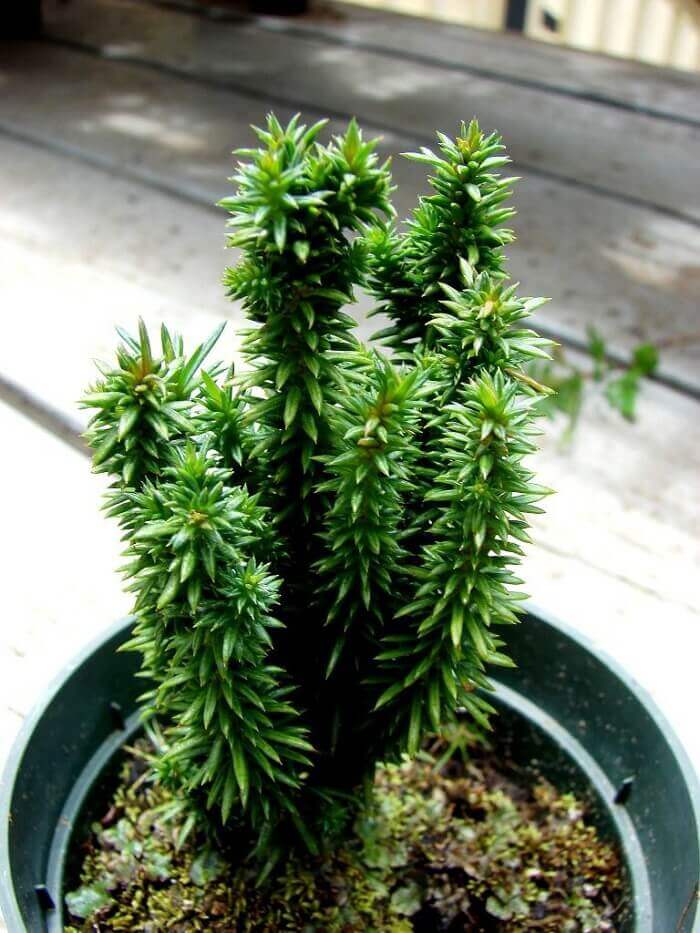

Description... Japanese cryptomeria is a coniferous, evergreen, elegant tree with blue-green, green or even burgundy, fragrant needles 1.5 - 2.5 cm long. Varieties with white needles at the ends of the branches have been bred. The trunk of the tree is covered with reddish-brown bark, which can flake off in long, vertical stripes. Unlike most conifers, this species has soft needles that densely cover the branches in a spiral. Mature trees have an attractive pyramidal or conical shape. Cones appear on the tips of branches, small - up to 3 cm in diameter and up to 5 cm long.
Height... Under natural conditions, it is very tall trees - up to 70 m, when grown in culture, it rarely exceeds 2 m.


